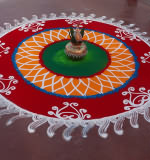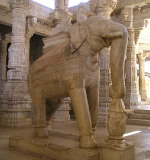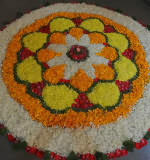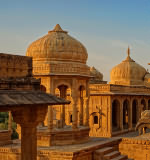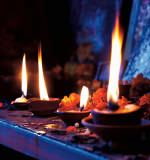| Download and install the indispensable font(s) to view Sanskrit in its full glory Read Transliterating (2) (English) to fully understand the transliteration system |
Tantrāloka (Tantraloka): Chapter 15 - stanzas 1 to 159 - Non-dual Shaivism of Kashmir
Dīkṣā sāmayī
Introduction
 This is the first set of stanzas (from the stanza 1 to the stanza 159) of the fifteenth chapter (called Dīkṣā sāmayī).
This is the first set of stanzas (from the stanza 1 to the stanza 159) of the fifteenth chapter (called Dīkṣā sāmayī).
This work was written by the great Master Abhinavagupta and is a compendium of Tantra in all its facets. Tantrāloka is the most important and voluminous work of the greatest Trika Master. Abhinavagupta was also the teacher of eminent Kṣemarāja and lived about 975-1025 AD in Kashmir.
This treatise whose name is Tantrāloka is a complete encyclopedia of Tantra. Since it is a very advanced text in Trika Shaivism, there is no surprise if a neophyte finds it difficult to understand. To start to understand it, the level of the reader must be the one of a real disciple in Trika Shaivism. If this requirement is not met, then there will be a lot of confusion and constant disappointment. Because in spite of my great efforts to explain the things so easily as possible, to study this treatise requires some spiritual caliber. In this system, sometimes it is not possible even to write about certain topics due to the extreme limitation of the words. Because in the end, all this knowledge has to do with 'states', and it is extremely difficult to write about 'states' in a precise way. Abhinavagupta has done his best to accomplish this formidable task of writing about what is superior and intangible. Anyway, despite his incredible skills to carry out this, he is not revealing everything. It is not because he is all the time hiding things from the reader, but because he is sometimes hiding and on other occasions he just cannot write about some extremely subtle topics because of the limitation of the words.
Goal of life is Liberation. Man has searched for freedom always in human history, but according to Trika Shaivism that is not real Liberation. Real Liberation does not mean that your body should be free from some prison and things like that. Real Liberation amounts to attaining His Svātantrya or Absolute Freedom. When the Great Lord's Svātantrya is achieved, then you see unity in all the things, i.e. you stop seeing duality as before. All is forever identified with Svātantrya, with Him, and that is the end of the story called 'you in bondage'. From this point on nothing will get in your way, because if something apparently gets in your way, that is Svātantrya again. This constant awareness of unity in all is real Freedom. There is no other attainment greater than this!
Keeping the above in mind, now read Tantrāloka and experience Supreme Delight, dear Śiva.
Important: All that is in brackets and italicized within the translation has been added by me in order to complete the sense of a particular phrase or sentence. In turn, all that is between double hyphen (--...--) constitutes clarifying further information also added by me.
Stanzas 1 to 10
अथ श्रीतन्त्रालोके पञ्चदशमाह्निकम्।
Atha śrītantrāloke pañcadaśamāhnikam|
Here begins (atha) the fifteenth (pañcadaśam) chapter (āhnikam) in venerable Tantrāloka (śrī-tantrāloke)|
अथैतदुपयोगाय यागस्तावन्निरूप्यते।
तत्र दीक्षैव भोगे च मुक्तौ चायात्युपायताम्॥१॥
स्वयं संस्कारयोगाद्वा तदङ्गं तत्प्रदर्श्यते।
यो यत्राभिलषेद्भोगान्स तत्रैव नियोजितः॥२॥
सिद्धिभाङ्मन्त्रशक्त्येति श्रीमत्स्वायम्भुवे विभुः।
योग्यतावशतो यत्र वासना यस्य तत्र सः॥३॥
योज्यो न च्यवते तस्मादिति श्रीमालिनीमते।
वदन्भोगाद्युपायत्वं दीक्षायाः प्राह नो गुरुः॥४॥
Athaitadupayogāya yāgastāvannirūpyate|
Tatra dīkṣaiva bhoge ca muktau cāyātyupāyatām||1||
Svayaṁ saṁskārayogādvā tadaṅgaṁ tatpradarśyate|
Yo yatrābhilaṣedbhogānsa tatraiva niyojitaḥ||2||
Siddhibhāṅmantraśaktyeti śrīmatsvāyambhuve vibhuḥ|
Yogyatāvaśato yatra vāsanā yasya tatra saḥ||3||
Yojyo na cyavate tasmāditi śrīmālinīmate|
Vadanbhogādyupāyatvaṁ dīkṣāyāḥ prāha no guruḥ||4||
And now (atha), firstly (tāvat), sacrifice --i.e. the ritual of worship-- (yāgaḥ) is described (nirūpyate) in order to contribute to the accomplishment of this --i.e. of initiation-- (etad-upayogāya).
There (tatra), initiation itself (dīkṣā eva) becomes a means (āyāti upāyatām) with reference to worldly enjoyment (bhoge) and (ca... ca) Liberation (muktau) (either) by itself (svayam) or (vā) by means of purificatory rites (saṁskāra-yogāt). Therefore (tad), that member/supplement (regarding initiation) --i.e. the sacrifice or ritual of worship-- (tad-aṅgam) is explained/taught (pradarśyate).
The All-pervasive One (vibhuḥ) (said) in venerable Svāyambhuvatantra (śrīmat-svāyambhuve): "He --i.e. the disciple-- (saḥ) who (yaḥ) desires (abhilaṣet) worldly enjoyments (bhogān) (is) placed/directed (niyojitaḥ) right there (tatra eva) where (yatra) he can have accomplishments/perfection (siddhi-bhāk) by the power of the Mantra-s (mantra-śaktyā iti)". In venerable Mālinīmatatantra (śrī-mālinīmate) He says (vadan): "He --viz. the disciple-- (saḥ) is to be placed/directed (yojyaḥ) there (tatra) where (yatra) his karmic tendency (vāsanā) (is active) due to (his) fitness (yogyatā-vaśatas). He does not fall (na cyavate) from that (tasmāt iti)". Our (nas) Guru (guruḥ) spoke about (prāha) initiation as a means (to obtain) worldly enjoyment, etc. (bhoga-ādi-upāyatvam dīkṣāyāḥ)||1-4||
न चाधिकारिता दीक्षां विना योगेऽस्ति शाङ्करे।
न च योगाधिकारित्वमेकमेवानया भवेत्॥५॥
अपि मन्त्राधिकारित्वं मुक्तिश्च शिवदीक्षया।
इत्यस्मिन्मालिनीवाक्ये साक्षान्मोक्षाभ्युपायता॥६॥
दीक्षायाः कथिता प्राच्यग्रन्थेन पुनरुच्यते।
पारम्पर्येण संस्कृत्या मोक्षभोगाभ्युपायता॥७॥
Na cādhikāritā dīkṣāṁ vinā yoge'sti śāṅkare|
Na ca yogādhikāritvamekamevānayā bhavet||5||
Api mantrādhikāritvaṁ muktiśca śivadīkṣayā|
Ityasminmālinīvākye sākṣānmokṣābhyupāyatā||6||
Dīkṣāyāḥ kathitā prācyagranthena punarucyate|
Pāramparyeṇa saṁskṛtyā mokṣabhogābhyupāyatā||7||
"(Nonetheless,) without (vinā) initiation (dīkṣām) there is no (na ca... asti) qualification (adhikāritā) in the Yoga of Śaṅkara (yoge... śāṅkare)" --this is the last portion of Mālinīvijayottaratantra 4.6--. "Through this initiation by Śiva (anayā... śiva-dīkṣayā) appears (bhavet) not only (na ca... ekam eva) qualification for Yoga (yoga-adhikāritvam) but also (api) authority regarding the Mantra-s (mantra-adhikāritvam) and (ca) Liberation (muktiḥ... iti)" --this is Mālinīvijayottaratantra 4.8--. In this statement in Mālinīvijayottaratantra (asmin mālinī-vākye), it is mentioned (kathitā) that initiation is the direct means to Liberation (sākṣāt mokṣa-abhyupāyatā... dīkṣāyāḥ). On the other hand (punar), by means of the previous verse (prācya-granthena), it is said (ucyate) that (initiation can also be) a means to (attain) Liberation and worldly enjoyment (mokṣa-bhoga-abhyupāyatā) through a purification (saṁskṛtyā) (taking place) by degrees (pāramparyeṇa)||5-7||
येषामध्यवसायोऽस्ति न विद्यां प्रत्यशक्तितः।
सुखोपायमिदं तेषां विधानमुदितं गुरोः॥८॥
इति श्रीमन्मतङ्गाख्ये ह्युक्ता मोक्षाभ्युपायता।
सम्यग्ज्ञानस्वभावा हि विद्या साक्षाद्विमोचिका॥९॥
Yeṣāmadhyavasāyo'sti na vidyāṁ pratyaśaktitaḥ|
Sukhopāyamidaṁ teṣāṁ vidhānamuditaṁ guroḥ||8||
Iti śrīmanmataṅgākhye hyuktā mokṣābhyupāyatā|
Samyagjñānasvabhāvā hi vidyā sākṣādvimocikā||9||
In the venerable (scripture) called Mataṅgatantra (śrīmat-mataṅga-ākhye hi) (initiation is) mentioned (uktā) (as) a means to (obtain) Liberation (mokṣa-abhyupāyatā): "This (idam) method (vidhānam) of the Guru (guroḥ) is said to be (uditam) an easy means (sukha-upāyam) for those (teṣām) who do not have (yeṣām... asti na) determination/resolution (adhyavasāyaḥ) with reference to Knowledge (vidyām prati) since they lack power (a-śaktitas... iti)".
Knowledge (vidyā), whose essential nature is a correct act of knowing (samyak-jñāna-svabhāvā hi), liberates (vimocikā) directly (sākṣāt)||8-9||
उक्तं तत्रैव तत्त्वानां कार्यकारणभावतः।
हेयादेयत्वकथने विद्यापाद इति स्फुटम्॥१०॥
Uktaṁ tatraiva tattvānāṁ kāryakāraṇabhāvataḥ|
Heyādeyatvakathane vidyāpāda iti sphuṭam||10||
(All this has been) clearly (sphuṭam) said (uktam) right there --i.e. the above-mentioned Mataṅgatantra-- (tatra eva), "in the chapter dealing with Knowledge" (vidyā-pāde iti), in (which there is) a narration/description about what is to be abandoned and taken (heya-ādeyatva-kathane) regarding the tattva-s or categories (tattvānām) according to (their) condition as cause and effect (kārya-kāraṇa-bhāvatas)||10||
Stanzas 11 to 20
तत्राशक्तास्तु ये तेषां दीक्षाचर्यासमाधयः।
ते विद्यापूर्वका यस्मात्तस्माज्ज्ञान्युत्तमोत्तमः॥११॥
Tatrāśaktāstu ye teṣāṁ dīkṣācaryāsamādhayaḥ|
Te vidyāpūrvakā yasmāttasmājjñānyuttamottamaḥ||11||
Initiation, caryā --regular performance of all rites, observance, right behavior, etc.-- and samādhi --i.e. a perfect absorption-- (dīkṣā-caryā-samādhayaḥ) are for those (teṣām) who (ye) are incompetent (aśaktāḥ tu) regarding that --i.e. regarding acquiring Knowledge directly-- (tatra).
Since (yasmāt) they --i.e. initiation, caryā and samādhi-- (te) are preceded by Knowledge (vidyā-pūrvakāḥ), therefore (tasmāt) the jñānī --the person with Knowledge-- (jñānī) is the best among the best (uttama-uttamaḥ)||11||
ज्ञानं च शास्त्रात्तच्चापि श्राव्यो नादीक्षितो यतः।
अतोऽस्य संस्क्रियामात्रोपयोगो दीक्षया कृतः॥१२॥
Jñānaṁ ca śāstrāttaccāpi śrāvyo nādīkṣito yataḥ|
Ato'sya saṁskriyāmātropayogo dīkṣayā kṛtaḥ||12||
Knowledge (jñānam ca) (comes) from the scripture (śāstrāt), and (ca api) as (yatas) someone who is not initiated (adīkṣitaḥ) should not hear --lit. "not to be heard", far-fetching Sanskrit here, in my opinion-- (śrāvyaḥ na) that --i.e. knowledge from scriptures-- (tad), therefore (atas) initiation does (dīkṣayā kṛtaḥ) for him (asya) only the application of a purification --literal translation but a little far-fetched and confusing; in other words, "initiation purifies a person and permits him to hear knowledge from scriptures"-- (saṁskriyā-mātra-upayogaḥ)||12||
यत्र तत्रास्तु गुरुणा योजितोऽसौ फलं पुनः।
स्वविज्ञानोचितं याति ज्ञानीत्युक्तं पुरा किल॥१३॥
Yatra tatrāstu guruṇā yojito'sau phalaṁ punaḥ|
Svavijñānocitaṁ yāti jñānītyuktaṁ purā kila||13||
It has been said (uktam) previously (purā) indeed (kila) that (iti) wherever (yatra tatra) a jñānī --a person of knowledge-- (asau... jñānī) be (astu) placed/directed (yojitaḥ) by (his) Guru (guruṇā), the fruit (phalam) becomes nevertheless (only) the suitable one for his (level of) knowledge (punar... sva-vijñāna-ucitam yāti)||13||
यस्य त्वीशप्रसादेन दिव्या काचन योग्यता।
गुरोः शिशोश्च तौ नैव प्रति दीक्षोपयोगिता॥१४॥
ज्ञानमेव तदा दीक्षा श्रीत्रैशिकनिरूपणात्।
सर्वशास्त्रार्थवेत्तृत्वमकस्माच्चास्य जायते॥१५॥
इति श्रीमालिनीनीत्या यः सांसिद्धिकसंविदः।
स उत्तमाधिकारी स्याज्ज्ञानवान्हि गुरुर्मतः॥१६॥
Yasya tvīśaprasādena divyā kācana yogyatā|
Guroḥ śiśośca tau naiva prati dīkṣopayogitā||14||
Jñānameva tadā dīkṣā śrītraiśikanirūpaṇāt|
Sarvaśāstrārthavettṛtvamakasmāccāsya jāyate||15||
Iti śrīmālinīnītyā yaḥ sāṁsiddhikasaṁvidaḥ|
Sa uttamādhikārī syājjñānavānhi gururmataḥ||16||
But (tu) (if) by the Grace of the Lord (yasya... īśa-prasādena), (there is) some (kācana) divine (divyā) fitness (yogyatā) in the case of Guru and disciple (guroḥ śiśoḥ ca), (then) they both do not need initiation --lit. initiation is of no use for them both-- (tau na eva prati dīkṣā-upayogitā).
From the definition (given) in venerable Traiśika --i.e. Parātrīśikā-- (śrī-traiśika-nirūpaṇāt), knowledge itself (jñānam eva) (is) then (tadā) initiation (dīkṣā).
According with the precept in venerable Mālinīvijayottaratantra (śrī-mālinī-nītyā): "And (ca) causelessly/suddenly (akasmāt) rises (jāyate) in him --in the one having this mark-- (asya) knowledge about the meaning of all the scriptures (sarva-śāstra-artha-vettṛtvam... iti)", he (saḥ) whose consciousness is natural/spontaneous (yaḥ sāṁsiddhika-saṁvidaḥ) has the best qualification (uttama-adhikārī syāt). A Guru (guruḥ) is undoubtedly considered (hi... mataḥ) to be someone who possesses knowledge (jñānavān)||14-16||
आत्मने वा परेभ्यो वा हितार्थी चेतयेदिदम्।
इत्युक्त्या मालिनीशास्त्रे तत्सर्वं प्रकटीकृतम्॥१७॥
Ātmane vā parebhyo vā hitārthī cetayedidam|
Ityuktyā mālinīśāstre tatsarvaṁ prakaṭīkṛtam||17||
All (sarvam) that (tad) has been manifested/shown/displayed (prakaṭīkṛtam) in Mālinīvijayottaratantra (mālinī-śāstre) through the statement --Abhinavagupta now paraphrases Mālinīvijayottaratantra 4.26-- (uktyā): "He who desires good (hita-arthī) for himself (ātmane) or (vā... vā) for others (parebhyaḥ) should be aware of (cetayet) this (idam... iti)"||17||
ज्ञानयोग्यास्तथा केचिच्चर्यायोग्यास्तथापरे।
दीक्षायोग्या योगयोग्या इति श्रीकैरणे विधौ॥१८॥
Jñānayogyāstathā keciccaryāyogyāstathāpare|
Dīkṣāyogyā yogayogyā iti śrīkairaṇe vidhau||18||
With reference to the rule (vidhau) (given) in venerable Kiraṇatantra (śrī-kairaṇe): "Some (kecid) are fit for knowledge (jñāna-yogyāḥ) while (tathā) (others) are fit for caryā --observance, performance of rituals, etc.-- (caryā-yogyāḥ), and (tathā) (even) others (apare) are fit for initiation (or) Yoga (dīkṣā-yogyāḥ yoga-yogyāḥ iti)"||18||
तत्रोक्तलक्षणः कर्मयोगज्ञानविशारदः।
उत्तरोत्तरताभूम्युत्कृष्टो गुरुरुदीरितः॥१९॥
Tatroktalakṣaṇaḥ karmayogajñānaviśāradaḥ|
Uttarottaratābhūmyutkṛṣṭo gururudīritaḥ||19||
The Guru (guruḥ) whose characteristics have been described there --in chapter 13 of this scripture, more specifically in 13.214-216-- (tatra-ukta-lakṣaṇaḥ) is conversant with rituals, Yoga and knowledge (of the scriptures) (karma-yoga-jñāna-viśāradaḥ). (A Guru) is said to be (udīritaḥ) superior according to the higher and higher stages --this means that the Guru who is conversant with Yoga is superior to the Guru who is conversant with rituals, and the Guru who is conversant with knowledge of the scriptures is superior to the other two previous Guru-s-- (uttara-uttaratā-bhūmi-utkṛṣṭaḥ)||19||
स च प्रागुक्तशक्त्यन्यतमपातपवित्रितम्।
परीक्ष्य पृष्ट्वा वा शिष्यं दीक्षाकर्म समाचरेत्॥२०॥
Sa ca prāguktaśaktyanyatamapātapavitritam|
Parīkṣya pṛṣṭvā vā śiṣyaṁ dīkṣākarma samācaret||20||
And (ca) he --i.e. the Guru-- (saḥ), after examining (parīkṣya) or (vā) interrogating (pṛṣṭvā) the disciple (śiṣyam) who has been purified by one of the many (kinds of) aforesaid Śaktipāta (prāk-ukta-śakti-anyatama-pāta-pavitritam), he performs (samācaret) the ritual of initiation (dīkṣā-karma)||20||
Stanzas 21 to 30
उक्तं स्वच्छन्दशास्त्रे च शिष्यं पृच्छेद्गुरुः स्वयम्।
फलं प्रार्थयसे यादृक्तादृक्साधनमारभे॥२१॥
वासनाभेदतः साध्यप्राप्तिर्मन्त्रप्रचोदिता।
मन्त्रमुद्राध्वद्रव्याणां होमे साधारणा स्थितिः॥२२॥
वासनाभेदतो भिन्नं शिष्याणां च गुरोः फलम्।
साधको द्विविधः शैवधर्मी लोकोज्झितस्थितिः॥२३॥
लोकधर्मी फलाकाङ्क्षी शुभस्थश्चाशुभोज्झितः।
द्विधा मुमुक्षुर्निर्बीजः समयादिविवर्जितः॥२४॥
बालबालिशवृद्धस्त्रीभोगभुग्व्याधितादिकः।
अन्यः सबीजो यस्येत्थं दीक्षोक्ता शिवशासने॥२५॥
विद्वद्द्वन्द्वसहानां तु सबीजा समयात्मिका।
दीक्षानुग्राहिका पाल्या विशेषसमयास्तु तैः॥२६॥
Uktaṁ svacchandaśāstre ca śiṣyaṁ pṛcchedguruḥ svayam|
Phalaṁ prārthayase yādṛktādṛksādhanamārabhe||21||
Vāsanābhedataḥ sādhyaprāptirmantrapracoditā|
Mantramudrādhvadravyāṇāṁ home sādhāraṇā sthitiḥ||22||
Vāsanābhedato bhinnaṁ śiṣyāṇāṁ ca guroḥ phalam|
Sādhako dvividhaḥ śaivadharmī lokojjhitasthitiḥ||23||
Lokadharmī phalākāṅkṣī śubhasthaścāśubhojjhitaḥ|
Dvidhā mumukṣurnirbījaḥ samayādivivarjitaḥ||24||
Bālabāliśavṛddhastrībhogabhugvyādhitādikaḥ|
Anyaḥ sabījo yasyetthaṁ dīkṣoktā śivaśāsane||25||
Vidvaddvandvasahānāṁ tu sabījā samayātmikā|
Dīkṣānugrāhikā pālyā viśeṣasamayāstu taiḥ||26||
It is also said (uktam) in Svacchandatantra (svacchanda-śāstre) : "The Guru (guruḥ) himself (svayam) should address --lit. should ask-- (pṛcchet) the disciple (śiṣyam) (in this way): 'Whatever the nature of (yādṛk tādṛk) the fruit (phalam) you desire (prārthayase), I begin (ārabhe) the means (sādhanam) --i.e. the Guru begins the respective ritual of initiation to acquire that fruit the disciple desires--'". The attainment of the goal (sādhya-prāptiḥ) is impelled by the Mantra-s (mantra-pracoditā) according to the different tendencies (in Guru and disciple) (vāsanā-bhedatas).
The state (sthitiḥ) of Mantra-s, Mudrā-s, paths and substances (mantra-mudrā-adhva-dravyāṇām) (which are offered) in oblation (home) is equal/similar (sādhāraṇā). The fruit (phalam) is different (bhinnam) according to the various tendencies (vāsanā-bhedatas) of the disciples (śiṣyāṇām) and (ca) of the Guru (guroḥ).
The sādhaka or adept (sādhakaḥ) is of two kinds (dvividhaḥ): (1) Śaivadharmī --he who follows Śiva's dharma, or else, he who has the characteristics of Śiva-- (śaiva-dharmī), whose condition is free from the world --i.e. he is not interested in the worldly matters-- (loka-ujjhita-sthitiḥ). (2) Lokadharmī --he who follows worldly dharma, or else, he who has the characteristics of the world-- (loka-dharmī). He desires fruits (phala-ākāṅkṣī), resides in good (actions) (śubha-sthaḥ) and (ca) is free from the (actions) which are not good (aśubha-ujjhitaḥ). (In turn, the putraka or spiritual son) who desires Liberation (mumukṣuḥ) is twofold (dvidhā): (1) Nirbījā or without seed (nis-bījaḥ), i.e. devoid of rules, etc. (samaya-ādi-vivarjitaḥ), (such as) children, fools, old people, women, people involved in worldly enjoyment, sick people, etc. (bāla-bāliśa-vṛddha-strī-bhoga-bhuk-vyādhita-ādikaḥ). (2) The other (kind) (anyaḥ) (is) Sabīja or with seed (sa-bījaḥ), whose (yasya) initiation (dīkṣā) is said to be (uktā) in this way (ittham) in the Śiva's doctrine (śiva-śāsane) for those who have knowledge and endure the pairs of opposites (vidvat-dvandva-sahānām tu): (It is) with seed (sa-bījā), viz. it consists of samaya-s or rules (samaya-ātmikā). (Such an) initiation (dīkṣā) favors/graces (anugrāhikā) (those people, and, consequently, its) especial rules (viśeṣa-samayāḥ) are to be observed (pālyāḥ) by them (taiḥ)||21-26||
अभावं भावयेत्सम्यक्कर्मणां प्राच्यभाविनाम्।
मुमुक्षोर्निरपेक्षस्य प्रारब्ध्रेकं न शोधयेत्॥२७॥
साधकस्य तु भूत्यर्थमित्थमेव विशोधयेत्।
शिवधर्मिण्यसौ दीक्षा लोकधर्मापहारिणी॥२८॥
अधर्मरूपिणामेव न शुभानां तु शोधनम्।
लोकधर्मिण्यसौ दीक्षा मन्त्राराधनवर्जिता॥२९॥
Abhāvaṁ bhāvayetsamyakkarmaṇāṁ prācyabhāvinām|
Mumukṣornirapekṣasya prārabdhrekaṁ na śodhayet||27||
Sādhakasya tu bhūtyarthamitthameva viśodhayet|
Śivadharmiṇyasau dīkṣā lokadharmāpahāriṇī||28||
Adharmarūpiṇāmeva na śubhānāṁ tu śodhanam|
Lokadharmiṇyasau dīkṣā mantrārādhanavarjitā||29||
(Now the Guru) should rightly contemplate (bhāvayet samyak) the absence (abhāvam) of past and future karma-s (karmaṇām prācya-bhāvinām) of the (disciple) who desires Liberation (mumukṣoḥ) (and) is indifferent (to worldly enjoyment) (nirapekṣasya). (The Guru should purify the past and future karma-s but) he should not purify (na śodhayet) that karma which has started (prārabdhṛ-ekam). But (tu) in the case of the sādhaka or adept (sādhakasya), (the Guru) should purify (viśodhayet) in this way (ittham eva) for the sake of worldly enjoyment --lit. of wellbeing, prosperity, etc.-- (bhūti-artham). That (asau) initiation (dīkṣā) (for the sādhaka or adept is called) Śivadharmiṇī (śiva-dharmiṇī) (and) removes worldly dharma (loka-dharma-apahāriṇī). That (asau) initiation (dīkṣā) (called) Lokadharmiṇī (loka-dharmiṇī), which is devoid of worship of Mantra-s (mantra-ārādhana-varjitā), (involves) a purification (śodhanam) of those (karma-s) which are not good only (adharma-rūpiṇām eva), but (tu) not (na) of those which are good (śubhānām)||27-29||
प्रारब्धदेहभेदे तु भुङ्क्तेऽसावणिमादिकान्।
भुक्त्वोर्ध्वं याति यत्रैष युक्तोऽथ सकलेऽकले॥३०॥
Prārabdhadehabhede tu bhuṅkte'sāvaṇimādikān|
Bhuktvordhvaṁ yāti yatraiṣa yukto'tha sakale'kale||30||
He -i.e. the disciple--- (asau) enjoys (bhuṅkte) the supernatural power of becoming as small as an atom, etc. (aṇimā-ādikān) in the kind of body that has started --i.e. in his current body-- (prārabdha-deha-bhede tu). Then (atha), after enjoying (all that) (bhuktvā), he moves upward (ūrdhvam yāti), to where (yatra) he (eṣaḥ) has been united/connected (by his own Guru) --viz. he moves upward to the tattva or category where his Guru has decided he should be-- (yuktaḥ), (whether this is the Śiva) with parts or without them (sakale akale)||30||
Stanzas 31 to 44
समयाचारपाशं तु निर्बीजायां विशोधयेत्।
दीक्षामात्रेण मुक्तिः स्याद्भक्त्या देवे गुरौ सदा॥३१॥
सद्योनिर्वाणदा सेयं निर्बीजा येति भण्यते।
अतीतानागतारब्धपाशत्रयवियोजिका॥३२॥
दीक्षावसाने शुद्धस्य देहत्यागे परं पदम्।
देहत्यागे सबीजायां कर्माभावाद्विपद्यते॥३३॥
समयाचारपाशं तु दीक्षितः पालयेत्सदा।
एवं पृष्ट्वा परिज्ञाय विचार्य च गुरुः स्वयम्॥३४॥
उचितां संविधित्सुस्तां वासनां तादृशीं श्रयेत्।
आयातशक्तिपातस्य दीक्षां प्रति न दैशिकः॥३५॥
अवज्ञां विदधीतेति शम्भुनाज्ञा निरूपिता।
स्वधनेन दरिद्रस्य कुर्याद्दीक्षां गुरुः स्वयम्॥३६॥
अपि दूर्वाम्बुभिर्यद्वा दीक्षायै भिक्षते शिशुः।
भिक्षोपात्तं निजं वाथ धनं प्राग्गुरवे शिशुः॥३७॥
दद्याद्येन विशुद्धं तद्यागयोग्यत्वमश्नुते।
तत्रादौ शिवतापत्तिस्वातन्त्र्यावेश एव यः॥३८॥
स एव हि गुरुः कार्यस्ततोऽसौ दीक्षणे क्षमः।
शिवतावेशिता चास्य बहूपाया प्रदर्शिता॥३९॥
क्रमिका बाह्यरूपा तु स्नानन्यासार्चनादिभिः।
बह्वीषु तासु तास्वेष क्रियासु शिवतां हृदि॥४०॥
सन्दधद्दृढमभ्येति शिवभावं प्रसन्नधीः।
शिवीभूतो यद्यदिच्छेत्तत्तत्कर्तुं समीहते॥४१॥
शिवाभिमानितोपायो बाह्यो हेतुर्न मोक्षदः।
शिवोऽयं शिव एवास्मीत्येवमाचार्यशिष्ययोः॥४२॥
हेतुतद्वत्तया दार्ढ्याभिमानो मोचको ह्यणोः।
नाध्यात्मेन विना बाह्यं नाध्यात्मं बाह्यवर्जितम्॥४३॥
सिद्ध्येज्ज्ञानक्रियाभ्यां तद्द्वितीयं सम्प्रकाशते।
श्रीब्रह्मयामले देव इति तेन न्यरूपयत्॥४४॥
Samayācārapāśaṁ tu nirbījāyāṁ viśodhayet|
Dīkṣāmātreṇa muktiḥ syādbhaktyā deve gurau sadā||31||
Sadyonirvāṇadā seyaṁ nirbījā yeti bhaṇyate|
Atītānāgatārabdhapāśatrayaviyojikā||32||
Dīkṣāvasāne śuddhasya dehatyāge paraṁ padam|
Dehatyāge sabījāyāṁ karmābhāvādvipadyate||33||
Samayācārapāśaṁ tu dīkṣitaḥ pālayetsadā|
Evaṁ pṛṣṭvā parijñāya vicārya ca guruḥ svayam||34||
Ucitāṁ saṁvidhitsustāṁ vāsanāṁ tādṛśīṁ śrayet|
Āyātaśaktipātasya dīkṣāṁ prati na daiśikaḥ||35||
Avajñāṁ vidadhīteti śambhunājñā nirūpitā|
Svadhanena daridrasya kuryāddīkṣāṁ guruḥ svayam||36||
Api dūrvāmbubhiryadvā dīkṣāyai bhikṣate śiśuḥ|
Bhikṣopāttaṁ nijaṁ vātha dhanaṁ prāggurave śiśuḥ||37||
Dadyādyena viśuddhaṁ tadyāgayogyatvamaśnute|
Tatrādau śivatāpattisvātantryāveśa eva yaḥ||38||
Sa eva hi guruḥ kāryastato'sau dīkṣaṇe kṣamaḥ|
Śivatāveśitā cāsya bahūpāyā pradarśitā||39||
Kramikā bāhyarūpā tu snānanyāsārcanādibhiḥ|
Bahvīṣu tāsu tāsveṣa kriyāsu śivatāṁ hṛdi||40||
Sandadhaddṛḍhamabhyeti śivabhāvaṁ prasannadhīḥ|
Śivībhūto yadyadicchettattatkartuṁ samīhate||41||
Śivābhimānitopāyo bāhyo heturna mokṣadaḥ|
Śivo'yaṁ śiva evāsmītyevamācāryaśiṣyayoḥ||42||
Hetutadvattayā dārḍhyābhimāno mocako hyaṇoḥ|
Nādhyātmena vinā bāhyaṁ nādhyātmaṁ bāhyavarjitam||43||
Siddhyejjñānakriyābhyāṁ taddvitīyaṁ samprakāśate|
Śrībrahmayāmale deva iti tena nyarūpayat||44||
In seedless (initiation) (nirbījāyām), (the Guru) should purify (viśodhayet) the bond of ordinances and rules (samaya-ācāra-pāśam tu). There is (syāt) Liberation (muktiḥ) only through initiation (dīkṣā-mātreṇa) due to constant (disciple's) devotion (bhaktyā... sadā) to God (deve) (and) Guru (gurau). "The one that gives immediate Nirvāṇa" (sadyas-nirvāṇa-dā): This very (sā iyam) seedless (initiation) (nirbījā) which (yā) is so called (iti bhaṇyate) liberates from the three bonds (known as) past, future and present --lit. started-- (karma) (atīta-anāgata-ārabdha-pāśa-traya-viyojikā).
In the case of him who has been purified (śuddhasya) at the conclusion of the initiation (dīkṣā-avasāne), (he attains) the Supreme State (param padam) when the body is abandoned --at the time of dying-- (deha-tyāge).
With regard to the (initiation) with seed (sa-bījāyām), (a person) falls (into bad states) (vipadyate) when the body is abandoned (deha-tyāge) due to the absence of practice and (due) actions (karma-abhāvāt). An initiate (dīkṣitaḥ) should always observe (pālayet sadā) the bond of ordinances and rules (samaya-ācāra-pāśam tu).
Thus (evam), after asking (the disciple) (pṛṣṭvā), after being aware of (him) (parijñāya) and (ca) after (duly) pondering (vicārya), the Guru (guruḥ) himself (svayam), desiring to perform (saṁvidhitsuḥ) the proper (initiation) (ucitām), should assume (śrayet) such a tendency (tām vāsanām tādṛśīm).
With respect to (prati) the initiation (dīkṣām) of someone who has obtained Śaktipāta (āyāta-śaktipātasya), the spiritual preceptor --i.e. the Guru-- (daiśikaḥ) should not despise (it) --according to the structure of the sentence, it refers to "initiation of someone who has obtained Śaktipāta" and not to "the person who obtained Śaktipāta"-- (avajñām vidadhīta). The (Śiva's) command (ājñā) has been thus described (iti... nirūpitā) by Śambhunātha --Abhinavagupta's Kulaguru-- (śambhunā).
The Guru (guruḥ) himself (svayam) should perform (kuryāt) the initiation (dīkṣām) of a poor (disciple) (daridrasya) with his own money (sva-dhanena), even if (api) with only dūrva grass and water (dūrva-ambubhiḥ). Or else (yadvā) the disciple (śiśuḥ) begs for alms (bhikṣate) in order to (pay for his) initiation (dīkṣāyai).
The disciple (śiśuḥ) should previously give (prāk... dadyāt) the Guru (gurave) his own (nijam) money (dham) or else (vā atha) (the money) obtained from begging for alms (bhikṣā-upāttam), so that (yena) it --i.e. the money-- (tad) (will) become pure and fit for the yāga or sacrifice --i.e. for the ritual-- (viśuddham... yāga-yogyatvam aśnute).
There (tatra), at first (ādau), only (eva hi) he (saḥ) who (yaḥ) has an absorption in the Absolute Freedom due to the attainment of the State of Śiva (śivatā-āpatti-svātantrya-āveśaḥ eva) is to be made (kāryaḥ) Guru (guruḥ). On that account (tatas), he (asau) is able (kṣamaḥ) to give initiation (dīkṣaṇe).
And (ca) his (asya) absorption in the State of Śiva (śivatā-āveśitā), which --i.e. the absorption-- has many means (bahu-upāyā), has (already) been shown/displayed (pradarśitā). But (tu) the gradual external (absorption) (kramikā bāhyarūpā) (which is accomplished) by ablutions, nyāsa --i.e. placing of the hands on various parts of the body, etc.--, worship, etc. (snāna-nyāsa-arcana-ādibhiḥ) (has not yet been shown/displayed).
He --the Guru-- (eṣaḥ), who is placid and kindly disposed (prasanna-dhīḥ) (is one) whose identification with Śiva --expecting "yasya śivabhāvaḥ"-- (śiva-bhāvam) becomes firm (dṛḍham abhyeti) by fixing --expecting "sandadhan"-- (sandadhat) the State of Śiva (śivatām) in (his) heart (hṛdi) in the middle of each of those many rituals (bahvīṣu tāsu tāsu... kriyāsu). (As) he has become Śiva (śivī-bhūtaḥ), whatever (yad yad) he desires (icchet) he strives for (samīhate) doing (kartum) that very thing (tad tad). The act of considering (oneself) to be Śiva (śiva-abhimānitā) (bestows the desired perfection/accomplishment). An external (bāhyaḥ) means (upāyaḥ) is not (na) the cause (hetuḥ) which gives Liberation (mokṣa-daḥ) --weird Sanskrit here--.
Thus (evam), in conformity with the cause (hetu-tadvattayā), the firm belief/opinion --expecting "dṛḍhābhimāna" instead-- (dārḍhya-abhimānaḥ), in both Ācārya --Guru-- and disciple (ācārya-śiṣyayoḥ), (that) "He (ayam) (is) Śiva (śivaḥ) (and) I am (asmi) Śiva (śivaḥ) Himself (eva... iti)" (is) the liberator (mocakaḥ) of the individual soul (aṇoḥ) indeed (hi).
For that reason (tena), in venerable Brahmayāmalatantra (śrī-brahmayāmale), God (devaḥ) described/defined (it) (nyarūpayat) so (iti): "That which is external (bāhyam) does not succeed (na... siddhyet) without (vinā) the (inner) Self (adhyātmena), (and) the (inner) Self (adhyātmam) does not succeed (na... siddhyet) without that which is external (bāhya-varjitam). The second one --Jayaratha, the famous Tantrāloka's commentator, affirmed that "the second one" is "the (inner) Self" in his commentary-- (tad-dvitīyam) shines (samprakāśate) with Knowledge and Action (jñāna-kriyābhyām)"||31-44||
Stanzas 45 to 60
श्रीमदानन्दशास्त्रे च नाशुद्धिः स्याद्विपश्चितः।
किन्तु स्नानं सुवस्त्रत्वं तुष्टिसञ्जननं भवेत्॥४५॥
तत्र प्रसिद्धदेहादिमातृनिर्मलताक्रमात्।
अयत्नतोऽन्तरन्तः स्यान्नैर्मल्यं स्नायतां ततः॥४६॥
Śrīmadānandaśāstre ca nāśuddhiḥ syādvipaścitaḥ|
Kintu snānaṁ suvastratvaṁ tuṣṭisañjananaṁ bhavet||45||
Tatra prasiddhadehādimātṛnirmalatākramāt|
Ayatnato'ntarantaḥ syānnairmalyaṁ snāyatāṁ tataḥ||46||
Also (ca), (it is said) in venerable Ānandatantra (śrīmat-ānanda-śāstre) (that) a wise person (vipaścitaḥ) is not (na... syāt) impure (aśuddhiḥ). Nevertheless (kintu), ablution (snānam) (and) good clothes (su-vastratvam) produce satisfaction (tuṣṭi-sañjananam bhavet) --very weird Sanskrit here--.
There (tatra), purity (nairmalyam) becomes (syāt) effortlessly (ayatnatas) more and more internal (antar antar) according to the progressive purity of the subject (associated) with the well-known body, etc. (prasiddha-deha-ādi-mātṛ-nirmalatā-kramāt). Therefore (tatas), a person should perform ablution --expecting "snāyāt"-- (snāyatām)||45-46||
स्नानं च देवदेवस्य यन्मूर्त्यष्टकमुच्यते।
तत्रैवं मन्त्रदीप्तेऽन्तर्मलदाहे निमज्जनम्॥४७॥
Snānaṁ ca devadevasya yanmūrtyaṣṭakamucyate|
Tatraivaṁ mantradīpte'ntarmaladāhe nimajjanam||47||
Ablution (snānam ca) which (yad) is said to be (ucyate) the group of the eight mūrti-s or forms (mūrti-aṣṭakam) of the God of gods (deva-devasya) (is) immersion (nimajjanam) there (tatra) (and) thus (evam) when they --i.e. the aforeasaid eight forms-- are inflamed by the Mantra-s (mantra-dīpte) in order to burn internal impurities up (antar-mala-dāhe) --far-fetched Sanskrit here really--||47||
तत्रेष्टमन्त्रहृदयो गोरजोऽन्तः पदत्रयम्।
गत्वागत्य भजेत्स्नानं पार्थिवं धृतिदायकम्॥४८॥
अस्त्रमन्त्रितमृद्धूतमलः पञ्चाङ्गमन्त्रितैः।
जलैर्मूर्धादिपादान्तं क्रमादाक्षालयेत्ततः॥४९॥
निमज्जेत्साङ्गमूलाख्यं जपन्ना तन्मयत्वतः।
उत्थायाशेषसज्ज्योतिर्देवतागर्भमम्बरे॥५०॥
सूर्यं जलेन मालिन्या तर्पयेद्विश्वतर्पकम्।
देवान्पितॄन्मुनीन्यक्षान्रक्षांस्यन्यच्च भौतिकम्॥५१॥
सर्वं सन्तर्पयेत्प्राणो वीर्यात्मा स च भास्करः।
ततो जपेत्परामेकां प्रागुक्तोच्चारयोगतः॥५२॥
आ तन्मयत्वसंवित्तेर्जलस्नानमिदं मतम्।
अग्न्युत्थं भस्म शस्त्रेण जप्त्वा मलनिबर्हणम्॥५३॥
कवक्त्रहृद्गुह्यपदे पञ्चाङ्गैर्भस्म मन्त्रितम्।
भस्ममुष्टिं साङ्गमूलजप्तां मूर्ध्नि क्षिपेत्ततः॥५४॥
हस्तपादौ जलेनैव प्रक्षाल्याचमनादिकम्।
तर्पणं जप इत्येवं भस्मस्नानं हि तैजसम्॥५५॥
गोरजोवत्यनुद्रिक्ते वायौ ह्लादिनि मन्त्रवाक्।
गत्यागतिप्रयोगे वा वायव्यं स्नानमाचरेत्॥५६॥
अमले गगने व्यापिन्येकाग्रीभूतदृष्टिकः।
स्मरन्मन्त्रं यदासीत कान्या निर्मलता ततः॥५७॥
यदि वा निर्मलाद्व्योम्नः पतता वारिणा तनुम्।
स्पर्शयेन्मन्त्रजपयुङ् नाभसं स्नानमीदृशम्॥५८॥
एवं सोमार्कतेजःसु शिवभावेन भावनात्।
निमज्जन्धौतमालिन्यः क्व वा योग्यो न जायते॥५९॥
आत्मैव परमेशानो निराचारमहाह्रदः।
विश्वं निमज्ज्य तत्रैव तिष्ठेच्छुद्धश्च शोधकः॥६०॥
Tatreṣṭamantrahṛdayo gorajo'ntaḥ padatrayam|
Gatvāgatya bhajetsnānaṁ pārthivaṁ dhṛtidāyakam||48||
Astramantritamṛddhūtamalaḥ pañcāṅgamantritaiḥ|
Jalairmūrdhādipādāntaṁ kramādākṣālayettataḥ||49||
Nimajjetsāṅgamūlākhyaṁ japannā tanmayatvataḥ|
Utthāyāśeṣasajjyotirdevatāgarbhamambare||50||
Sūryaṁ jalena mālinyā tarpayedviśvatarpakam|
Devānpitṝnmunīnyakṣānrakṣāṁsyanyacca bhautikam||51||
Sarvaṁ santarpayetprāṇo vīryātmā sa ca bhāskaraḥ|
Tato japetparāmekāṁ prāguktoccārayogataḥ||52||
Ā tanmayatvasaṁvitterjalasnānamidaṁ matam|
Agnyutthaṁ bhasma śastreṇa japtvā malanibarhaṇam||53||
Kavaktrahṛdguhyapade pañcāṅgairbhasma mantritam|
Bhasmamuṣṭiṁ sāṅgamūlajaptāṁ mūrdhni kṣipettataḥ||54||
Hastapādau jalenaiva prakṣālyācamanādikam|
Tarpaṇaṁ japa ityevaṁ bhasmasnānaṁ hi taijasam||55||
Gorajovatyanudrikte vāyau hlādini mantravāk|
Gatyāgatiprayoge vā vāyavyaṁ snānamācaret||56||
Amale gagane vyāpinyekāgrībhūtadṛṣṭikaḥ|
Smaranmantraṁ yadāsīta kānyā nirmalatā tataḥ||57||
Yadi vā nirmalādvyomnaḥ patatā vāriṇā tanum|
Sparśayenmantrajapayuṅ nābhasaṁ snānamīdṛśam||58||
Evaṁ somārkatejaḥsu śivabhāvena bhāvanāt|
Nimajjandhautamālinyaḥ kva vā yogyo na jāyate||59||
Ātmaiva parameśāno nirācāramahāhradaḥ|
Viśvaṁ nimajjya tatraiva tiṣṭhecchuddhaśca śodhakaḥ||60||
There (tatra), someone who has in his heart the chosen Mantra (iṣṭa-mantra-hṛdayaḥ), after going in and out (antar... gatvā āgatya) three steps (pada-trayam) of (a pile of) cow dung --lit. cow dust-- (go-rajas), is engaged in/receives (bhajet) the ablution (snānam) of earth (pārthivam), which grants firmness/steadiness (dhṛti-dāyakam).
Once that person has removed the impurity of earth with the mantra weapon --i.e. with Phaṭ-- (astra-mantrita-mṛd-dhūta-malaḥ), he should progressively sprinkle (kramāt ākṣālayet) (all of his body,) starting with the head and ending in the feet (mūrdha-ādi-pāda-antam), with water (jalaiḥ) which has been consecrated with the five limbs --it refers to the nyāsa of the Vidyāṅgapañcakam, which will be mentioned by Abhinavagupta in the stanza 250 later on-- (pañcāṅgamantritaiḥ). After that (tatas), he should immerse (nimajjet) (the body) while muttering (japan) that which is called root (Mantra) together with (its) limbs (sa-aṅga-mūla-ākhyam) until it becomes one with that (ā tad-mayatvatas). After getting up (utthāya), (he should go out and) please/gratify/satisfy (tarpayet), with water and Mālinī (jalena mālinyā), the sun (sūryam) that pleases/gratifies/satisfies all the things --or "the universe"-- (viśva-tarpakam) (and that) in the sky (ambare) contains all the true deities of the light (aśeṣa-sat-jyotis-devatā-garbham).
He (saḥ ca) (is) the sun (bhāskaraḥ) (and) the vital energy (prāṇaḥ) which is the virility (vīrya-ātmā). He pleases (santarpayet) the gods (devān), the forefathers (pitṝn), the sages (munīn), the yakṣa-s (yakṣān), the demons (rakṣāṁsi) and (ca) all (sarvam) the other (anyat) beings living in the elemental/material universe (bhautikam). After that (tatas), he should mutter (japet) the single (Mantra) (ekām) of Parā --i.e. Sauḥ-- (parām) by means of the aforesaid pronunciation (prākukta-uccāra-yogatas) until consciousness attains unity with that --viz. with Sauḥ-- (ā tad-mayatva-saṁvitteḥ). This (idam) is considered to be (matam) the ablution with water (jala-snānam).
After muttering (the Mantra) (japtvā) which is a weapon --i.e. Phaṭ; expecting "śastram"-- (śastreṇa) on the ash (bhasma) which has arisen from fire --expecting "agnyutthe bhasmani"-- (agni-uttham) (there is annihilation) of the impurity (mala-nibarhaṇam) (residing) in head, mouth, heart, genitals and feet (ka-vaktra-hṛd-guhya-pade). The ash (bhasma) (is) consecrated (mantritam) with the five limbs (pañca-aṅgaiḥ). After that (tatas), he should throw (kṣipet) a handful of ashes (bhasma-muṣṭim) —over which the root (Mantra) along with the limbs has been muttered (sa-aṅga-mūla-japtām)— on (his) head (mūrdhni). After sprinkling/purifying (prakṣālya) hands and feet (hasta-pādau) with water (jalena eva), (there should be) sipping of the water (from the palm of the hand), etc. (ācamana-ādikam). (Next, there should be) satisfaction/gratification (by libations) (tarpaṇam) (and) muttering of the Mantra (japaḥ). (This) brilliant and splendid (taijasam) ablution with ashes (bhasma-snānam hi) (is) so (iti evam).
He who utters Mantra-s (mantra-vāk) should perform (ācaret) the ablution (snānam) with air --lit. relating to air-- (vāyavyam) in a refreshing wind (vāyau hlādini) which is not excessive --i.e. whic is not very strong-- (anudrikte) (and) which contains cow dust --viz. the dust of cow dung; I read "gorajovati" but Jayaratha reads "gorajovatī"-- (go-rajas-vati), or else (vā) by the practice of coming and going --so you will receive air on your body, I guess-- (gatyāgati-prayoge).
If (yad) (there is) someone who has become one-pointed while watching (ekāgrī-bhūta-dṛṣṭikaḥ) the pure pervasive sky (amale gagane vyāpini) while remembering (smaran) the Mantra (mantram), (then) what (kā) other (anyā) (better) purity (nirmalatā) than that (tatas) could there be --lit. "could remain", expecting "sīta" instead; others read "āsītā"-- (āsīta)? Or if (yadi vā) someone who is muttering the Mantra (mantra-japa-yuj) makes (his) body be touched (tanum... sparśayet) by the water (vāriṇā) that falls (patatā) from a pure sky (nirmalāt vyomnaḥ), such (an act) (īdṛśam) (is) the ablution (snānam) with the ether --lit. relating to the ether-- (nābhasam).
Thus (evam), he who immerses (himself) (nimajjat) in the splendor of moon and sun (soma-arka-tejaḥsu) while contemplating (bhāvanāt) (his unity) with the State of Śiva (śiva-bhāvena) (becomes) someone who has been purified from impurity (dhauta-mālinyaḥ). Where (kva vā) does he not become fit (yogyaḥ na jāyate)?
The Self Himself (ātmā eva) (is) the Supreme Lord (parama-īśānaḥ) who is the Great Lake devoid of ācāra-s or practices (nis-ācāra-mahā-hradaḥ). Having immersed (nimajjya) the universe (viśvam) right there (tatra eva), he remains (tiṣṭhet) (as) pure (śuddhaḥ) and (ca) purifying (śodhakaḥ)||48-60||
Stanzas 61 to 76
इति स्नानाष्टकं शुद्धावुत्तरोत्तरमुत्तमम्।
सर्वत्र पश्चात्तं मन्त्रमेकीभूतमुपाहरेत्॥६१॥
Iti snānāṣṭakaṁ śuddhāvuttarottaramuttamam|
Sarvatra paścāttaṁ mantramekībhūtamupāharet||61||
Thus (iti), the excellent (uttamam) group of eight ablutions (snāna-aṣṭakam) has to do with higher and higher levels (uttara-uttaram) regarding purity (śuddhau) --Sanskrit could have bee much better--. In all of them --in all of the eight ablutions-- (sarvatra), the person should take away (upāharet) afterward (paścāt) that Mantra which has become one (with his own Self) (tam mantram ekībhūtam)||61||
धृत्याप्यायमलप्लोषवीर्यव्याप्तिसृजिस्थितीः।
अभेदं च क्रमादेति स्नानाष्टकपरो मुनिः॥६२॥
एता ह्यनुग्रहात्मानो मूर्तयोऽष्टौ शिवात्मिकाः।
स्वरूपशिवरूपाभ्यां ध्यानात्तत्तत्फलप्रदाः॥६३॥
Dhṛtyāpyāyamalaploṣavīryavyāptisṛjisthitīḥ|
Abhedaṁ ca kramādeti snānāṣṭakaparo muniḥ||62||
Etā hyanugrahātmāno mūrtayo'ṣṭau śivātmikāḥ|
Svarūpaśivarūpābhyāṁ dhyānāttattatphalapradāḥ||63||
The sage (muniḥ) who is devoted to the group of eight ablutions (snāna-aṣṭaka-paraḥ) progressively (kramāt) obtains --lit. he goes-- (eti) firmness/steadiness --a quality of the earth element--, nourishment --the water element--, burning of impurities --the fire element--, virility --the air element--, pervasion --the ether/space element--, the capacity to manifest and maintain (the universe) --moon and sun-- (dhṛti-āpyāya-mala-ploṣa-vīrya-vyāpti-sṛji-sthitīḥ) and (ca) unity --the Self, i.e. the Great Lord-- (abhedam).
These (etāḥ hi) eight (aṣṭau) forms (mūrtayaḥ) consist of Grace/Favor and Śiva (anugraha-ātmānaḥ... śiva-ātmikāḥ). Through meditation (on them) (dhyānāt), in accordance with their own essential nature and Śiva (svarūpa-śiva-rūpābhyām), they grant various fruits (tad-tad-phala-pradāḥ)||62-63||
अनेन विधिनार्चायां कन्दाधारादियोजनाम्।
कुर्वन्व्याससमासाभ्यां धरादेस्तत्फलं भजेत्॥६४॥
तथा हि योगसञ्चारे मन्त्राः स्युर्भुवि पार्थिवाः।
आप्ये आप्या यावदमी शिवे शिवमया इति॥६५॥
Anena vidhinārcāyāṁ kandādhārādiyojanām|
Kurvanvyāsasamāsābhyāṁ dharādestatphalaṁ bhajet||64||
Tathā hi yogasañcāre mantrāḥ syurbhuvi pārthivāḥ|
Āpye āpyā yāvadamī śive śivamayā iti||65||
By this procedure (anena vidhinā), he who makes (kurvan), individually or collectively, the union of the earth, etc. (inside) the support of Kanda, etc. --Kanda is the bulb from where all nāḍī-s (subtle channels) emerge-- (kanda-ādhāra-ādi-yojanām... vyāsa-samāsābhyām dharā-ādeḥ) during the worship (arcāyām), receives (bhajet) that fruit (tad-phalam).
For instance (tathā hi), in Yogasañcāratantra (yogasañcāre), the Mantra-s (mantrāḥ) are (syuḥ) earthen (pārthivāḥ) in the earth element (bhuvi), watery (āpyāḥ) in the water element (āpye), until (yāvat) they (amī) (are) "made of Śiva" (śiva-mayāḥ... iti) in Śiva (śive)||64-65||
श्रीनिर्मर्यादशास्त्रेऽपि तदित्थं सुनिरूपितम्।
धरादेश्च विशेषोऽस्ति वीरसाधकसम्मतः॥६६॥
रणरेणुर्वीरजलं वीरभस्म महामरुत्।
श्मशानारण्यगगनं चन्द्रार्कौ तदुपाहितौ॥६७॥
आत्मा निर्धूतनिःशेषविकल्पातङ्कसुस्थितः।
स्नानार्चादावित्युपास्यं वीराणां विग्रहाष्टकम्॥६८॥
Śrīnirmaryādaśāstre'pi taditthaṁ sunirūpitam|
Dharādeśca viśeṣo'sti vīrasādhakasammataḥ||66||
Raṇareṇurvīrajalaṁ vīrabhasma mahāmarut|
Śmaśānāraṇyagaganaṁ candrārkau tadupāhitau||67||
Ātmā nirdhūtaniḥśeṣavikalpātaṅkasusthitaḥ|
Snānārcādāvityupāsyaṁ vīrāṇāṁ vigrahāṣṭakam||68||
That (tad) is well described (su-nirūpitam) in this way (ittham) in venerable Nirmaryādatantra (śrī-nirmaryāda-śāstre) too (api) (on affirming that) there is (asti) a especial (aspect) (viśeṣaḥ) of the earth element, etc. (dharā-ādeḥ ca) which is highly honored by the kaula heroes who are adepts (vīra-sādhaka-sammataḥ): (1) Dust of a battlefield --earth-- (raṇa-reṇuḥ), (2) water of the heroes --urine, i.e. water-- (vīra-jalam), (3) ash of the hero --fire-- (vīra-bhasma), (4) great wind --air-- (mahā-marut), (5) the sky on burning ground/cemetery and forest --space-- (śmaśāna-āraṇya-gaganam), (6 and 7) the sun --arka-- and the moon --candra-- (candra-arkau) (are those things) connected with them (tad-upāhitau), (and) (8) the Self (ātmā) who is well established (in a State) where all the affliction (called) vikalpa-s --i.e. thoughts-- has been removed (nirdhūta-niḥśeṣa-vikalpa-ātaṅka-susthitaḥ). In the case of the (kaula) heroes (vīrāṇām), the group of eight forms (vigraha-aṣṭakam) is to be honored (upāsyam) like that (iti) during ablution, worship, etc. (snāna-arcā-ādau)||66-68||
श्रीमत्त्रिशिरसि प्रोक्तं मद्यशीधुसुरादिना।
सुस्वादुना प्रसन्नेन तनुना सुसुगन्धिना॥६९॥
कन्दलादिगतेनान्तर्बहिः संस्कारपञ्चकम्।
कृत्वा निरीक्षणं प्रोक्ष्य ताडनाप्यायगुण्ठनम्॥७०॥
मन्त्रचक्रस्य तन्मध्ये पूजां विप्रुट्प्रतर्पणम्।
तेनात्मसेकः कलशमुद्रया चाभिषेचनम्॥७१॥
देवतातर्पणं देहप्राणोभयपथाश्रितम्।
सर्वतीर्थतपोयज्ञदानादिफलमश्नुते॥७२॥
मद्यस्नाने साधकेन्द्रो मुमुक्षुः केवलीभवेत्।
यतः शिवमयं मद्यं सर्वे मन्त्राः शिवोद्भवाः॥७३॥
शिवशक्त्योर्न भेदोऽस्ति शक्त्युत्थास्तु मरीचयः।
तासामानन्दजनकं मद्यं शिवमयं ततः॥७४॥
प्रबुद्धे संविदः पूर्णे रूपेऽधिकृतिभाजनम्।
मन्त्रध्यानसमाधानभेदात्स्नानं तु यन्न तत्॥७५॥
युक्तं स्नानं यतो न्यासकर्मादौ योग्यतावहम्।
अस्य स्नानाष्टकस्यास्ति बाह्यान्तरतया द्विता॥७६॥
Śrīmattriśirasi proktaṁ madyaśīdhusurādinā|
Susvādunā prasannena tanunā susugandhinā||69||
Kandalādigatenāntarbahiḥ saṁskārapañcakam|
Kṛtvā nirīkṣaṇaṁ prokṣya tāḍanāpyāyaguṇṭhanam||70||
Mantracakrasya tanmadhye pūjāṁ vipruṭpratarpaṇam|
Tenātmasekaḥ kalaśamudrayā cābhiṣecanam||71||
Devatātarpaṇaṁ dehaprāṇobhayapathāśritam|
Sarvatīrthatapoyajñadānādiphalamaśnute||72||
Madyasnāne sādhakendro mumukṣuḥ kevalībhavet|
Yataḥ śivamayaṁ madyaṁ sarve mantrāḥ śivodbhavāḥ||73||
Śivaśaktyorna bhedo'sti śaktyutthāstu marīcayaḥ|
Tāsāmānandajanakaṁ madyaṁ śivamayaṁ tataḥ||74||
Prabuddhe saṁvidaḥ pūrṇe rūpe'dhikṛtibhājanam|
Mantradhyānasamādhānabhedātsnānaṁ tu yanna tat||75||
Yuktaṁ snānaṁ yato nyāsakarmādau yogyatāvaham|
Asya snānāṣṭakasyāsti bāhyāntaratayā dvitā||76||
In venerable Triśirobhairavatantra (śrīmat-triśirasi), a group of five internal and external purificatory rites (antar-bahis saṁskāra-pañcakam) —by looking at (nirīkṣaṇam), sprinkling (prokṣya), beating, nourishing and covering (tāḍana-āpyāya-guṇṭhanam)— is performed --lit. doing-- (kṛtvā) by means of wine, śīdhu --probably "rum"--, surā --a spirituous liquor--, etc. (madya-śīdhu-surā-ādinā), which have good taste (su-svādunā), which are clear (prasannena) (and) delicate (tanunā), which smell extremely well (su-su-gandhinā) (and) are inside a skull --expecting "kapāla" and not "kandala"--, etc. (kandala-ādi-gatena). (After that, the yogī should perform) the worship (pūjām) of the group of Mantra-s (mantra-cakrasya), (and he also should perform) the libation with drops (of wine, rum, liquor, etc.) (vipruṭ-pratarpaṇam) in the middle of that --viz. in the middle of the group of Mantra-s-- (tad-madhye). (There should be) sprinkling on himself (ātma-sekaḥ) with that --with the alcoholic beverage-- (tena) and also (ca) consecration (abhiṣecanam) by the mudrā or gesture of the pot (kalaśa-mudrayā). (Next, there should be) offering of libation to the deties (devatā-tarpaṇam), (and this offering of libation) is based on the body and on both paths of the vital energy --another translation might be "is based on both paths of body and vital energy"-- (deha-prāṇa-ubhaya-patha-āśritam). (Then, on the one hand,) the best of the sādhaka-s or adepts --the sādhaka-s generally are desirous for worldly enjoyments-- (sādhaka-indraḥ), during the ablution with wine (madya-snāne), obtains (aśnute) the fruit of (visiting) all the places of pilgrimage, (practicing) austerities, (performing) sacrificial rituals, (practicing) charity, etc. (sarva-tīrtha-tapas-yajña-dāna-ādi-phalam). (On the other hand,) he who desires Liberation (mumukṣuḥ) gets It --lit. becomes isolated-- (kevalī-bhavet).
Because (yatas) wine (madyam) is made of Śiva (śiva-mayam) (and) all (sarve) the Mantra-s (mantrāḥ) spring from Śiva (śiva-udbhavāḥ). There is no (na... asti) difference (bhedaḥ) between Śiva and Śakti (śiva-śaktyoḥ). The rays of Light (marīcayaḥ) arise from Śakti (śakti-utthāḥ tu) (and) wine (madyam) consisting of Śiva (śiva-mayam) generates bliss (ānanda-janakam) for them --i.e. for those rays of Light-- (tāsām). On that account (tatas), he is a receptacle of competence and authority (adhikṛti-bhājanam) with reference to the awakened and full Form/Nature (prabuddhe... pūrṇe rūpe) of Consciousness (saṁvidaḥ).
It is not (na tad) proper (yuktam) (to say) that (yad) ablution (snānam tu) (is different) from the division/variety of Mantra, meditation and samādhi (mantra-dhyāna-samādhāna-bhedāt), because (yatas) ablution (snānam) brings fitness (yogyatā-āvaham) with regard to nyāsa, rituals, etc. (nyāsa-karma-ādau). In the case of this group of eight ablutions (asya snāna-aṣṭakasya), there is (asti) a duality (dvitā) in the form of external and internal (bāhya-antaratayā)||69-76||
Stanzas 77 to 145
आन्तरं तद्यथोर्ध्वेन्दुधारामृतपरिप्लवः।
यतो रन्ध्रोर्ध्वगाः सार्धमङ्गुलं व्याप्य संस्थिताः॥७७॥
मूर्तयोऽष्टावपि प्रोक्ताः प्रत्येकं द्वादशान्ततः।
एषामेकतमं स्नानं कुर्याद्द्वित्र्यादिशोऽपि वा॥७८॥
Āntaraṁ tadyathordhvendudhārāmṛtapariplavaḥ|
Yato randhrordhvagāḥ sārdhamaṅgulaṁ vyāpya saṁsthitāḥ||77||
Mūrtayo'ṣṭāvapi proktāḥ pratyekaṁ dvādaśāntataḥ|
Eṣāmekatamaṁ snānaṁ kuryāddvitryādiśo'pi vā||78||
The internal (ablution) (āntaram), that is to say (tad yathā), an inundation/flood of Nectar (flowing like) a stream from the higher moon (ūrdhva-indu-dhārā-amṛta-pariplavaḥ), (takes place then. Why?) Because (yatas) the eight (aṣṭau api) forms (mūrtayaḥ) are said to be (proktāḥ) situated (saṁsthitāḥ) above Brahmarandhra --the hole in the crown of the head, at twelve fingers' breadth from the space between the eyebrows-- (randhra-ūrdhva-gāḥ), each of them (pratyekam) penetrating (vyāpya) one and a half fingers' breadth (sārdham aṅgulam) up to dvādaśānta --i.e. up to Mahāvyoma, the Great Ether, at twelve fingers' breadth of Brahmarandhra-- (dvādaśāntatas).
He should perform (kuryāt) one (ekatamam) of these ablutions (eṣām... snānam), or else (api vā) two, three, etc. (dvi-tri-ādiśas)||77-78||
इति स्नानविधिः प्रोक्तो भैरवेणामलीकृतौ।
स्नानानन्तरकर्तव्यमथेदमुपदिश्यते॥७९॥
भावं प्रसन्नमालोच्य व्रजेद्यागगृहं ततः।
पर्वताग्रनदीतीरैकलिङ्गादि यदुच्यते॥८०॥
तद्बाह्यमिह तत्सिद्धिविशेषाय न मुक्तये।
आभ्यन्तरं नगाग्रादि देहान्तः प्राणयोजनम्॥८१॥
साधकानामुपायः स्यात्सिद्धये नतु मुक्तये।
पीठस्थानं सदा यागयोग्यं शास्त्रेषु भण्यते॥८२॥
तच्च बाह्यान्तराद्रूपाद्बहिर्देहे च सुस्फुटम्।
यतः श्रीनैशसञ्चारे परमेशो न्यरूपयत्॥८३॥
तस्येच्छा पीठमाधारो यत्रस्थं सचराचरम्।
अग्र्यं तत्कामरूपं स्याद्बिन्दुनादद्वयं ततः॥८४॥
नादपीठं पूर्णगिरिर्दक्षिणे वामतः पुनः।
पीठमुड्डयनं बिन्दुर्मुख्यं पीठत्रयं त्विदम्॥८५॥
ज्ञेयं सङ्कल्पनारूपमर्धपीठमतः परम्।
शाक्तं कुण्डलिनी वेदकलं च त्र्युपपीठकम्॥८६॥
देवीकोट्टोज्जयिन्यौ द्वे तथा कुलगिरिः परः।
लालनं बैन्दवं व्याप्तिरिति सन्दोहकत्रयम्॥८७॥
पुण्ड्रवर्धनवारेन्द्रे तथैकाम्रमिदं बहिः।
नवधा कथितं पीठमन्तर्बाह्यक्रमेण तत्॥८८॥
क्षेत्राष्टकं क्षेत्रविदो हृदम्भोजदलाष्टकम्।
प्रयागो वरणा पश्चादट्टहासो जयन्तिका॥८९॥
वाराणसी च कालिङ्गं कुलूता लाहुला तथा।
उपक्षेत्राष्टकं प्राहुर्हृत्पद्माग्रदलाष्टकम्॥९०॥
विरजैरुडिका हाला एला पूः क्षीरिका पुरी।
मायाख्या मरुदेशश्च बाह्याभ्यन्तररूपतः॥९१॥
हृत्पद्मदलसन्धीनामुपसन्दोहकाष्टता।
जालन्धरं च नैपालं कश्मीरा गर्गिका हरः॥९२॥
म्लेच्छदिग्द्वारवृत्तिश्च कुरुक्षेत्रं च खेटकम्।
द्विपथं द्वयसङ्घट्टात्त्रिपथं त्रयमेलकात्॥९३॥
चतुष्पथं शक्तिमतो लयात्तत्रैव मन्वते।
नासान्ततालुरन्ध्रान्तमेतद्देहे व्यवस्थितम्॥९४॥
भ्रूमध्यकण्ठहृत्सञ्ज्ञं मध्यमं तदुदाहृतम्।
नाभिकन्दमहानन्दधाम तत्कौलिकं त्रयम्॥९५॥
पर्वताग्रं नदीतीरमेकलिङ्गं तदेव च।
किं वातिबहुना सर्वं संवित्तौ प्राणगं ततः॥९६॥
ततो देहस्थितं तस्माद्देहायतनगो भवेत्।
बाह्ये तु तादृशान्तःस्थयोगमार्गविशारदाः॥९७॥
देव्यः स्वभावाज्जायन्ते पीठं तद्वाह्यमुच्यते।
यथा स्वभावतो म्लेच्छा अधर्मपथवर्तिनः॥९८॥
तत्र देशे नियत्येत्थं ज्ञानयोगौ स्थितौ क्वचित्।
यथाचातन्मयोऽप्येति पापितां तैः समागमात्॥९९॥
तथा पीठस्थितोऽप्येति ज्ञानयोगादिपात्रताम्।
मुख्यत्वेन शरीरेऽन्तः प्राणे संविदि पश्यतः॥१००॥
विश्वमेतत्किमन्यैः स्याद्बहिर्भ्रमणडम्बरैः।
इत्येवमन्तर्बाह्ये च तत्तच्चक्रफलार्थिनाम्॥१०१॥
स्थानभेदो विचित्रश्च स शास्त्रे सङ्ख्ययोज्झितः।
श्रीवीरावलिहृदये सप्त स्थानानि शक्तिकमलयुगम्॥१०२॥
सुरपथचतुष्पथाख्यश्मशानमेकान्तशून्यवृक्षौ च।
इति निर्वचनगुणस्थित्युपचारदृशा विबोध एवोक्तः॥१०३॥
तदधिष्ठिते च चक्रे शारीरे बहिरथो भवेद्यागः।
मुक्तये तन्न यागस्य स्थानभेदः प्रकल्प्यते॥१०४॥
देशोपाया न सा यस्मात्सा हि भावप्रसादतः।
उक्तं च श्रीनिशाचारे सिद्धिसाधनकाङ्क्षिणाम्॥१०५॥
स्थानं मुमुक्षुणा त्याज्यं सर्पकञ्चुकवत्त्विदम्।
मुक्तिर्न स्थानजनिता यदा श्रोत्रपथं गतम्॥१०६॥
गुरोस्तत्त्वं तदा मुक्तिस्तद्दार्ढ्याय तु पूजनम्।
यत्र यत्र हृदम्भोजं विकासं प्रतिपद्यते॥१०७॥
तत्रैव धाम्नि बाह्येऽन्तर्यागश्रीः प्रतितिष्ठति।
नान्यत्रगत्या मोक्षोऽस्ति सोऽज्ञानग्रन्थिकर्तनात्॥१०८॥
तच्च संविद्विकासेन श्रीमद्वीरावलीपदे।
गुरवस्तु विमुक्तौ वा सिद्धौ वा विमला मतिः॥१०९॥
हेतुरित्युभयत्रापि यागौको यन्मनोरमम्।
नियतिप्राणतायोगात्सामग्रीतस्तु यद्यपि॥११०॥
सिद्धयो भाववैमल्यं तथापि निखिलोत्तमम्।
विमलीभूतहृदयो यत्तत्र प्रतिबिम्बयेत्॥१११॥
साध्यं तदस्य दार्ढ्येन सफलत्वाय कल्पते।
उक्तं श्रीसारशास्त्रे च निर्विकल्पो हि सिध्यति॥११२॥
क्लिश्यन्ते सविकल्पास्तु कल्पोक्तेऽपि कृते सति।
तदाक्रम्य बलं मन्त्रा अयमेवोदयः स्फुटः॥११३॥
इत्यादिभिः स्पन्दवाक्यैरेतदेव निरूपितम्।
तस्मात्सिद्ध्यै विमुक्त्यै वा पूजाजपसमाधिषु॥११४॥
तत्स्थानं यत्र विश्रान्तिसुन्दरं हृदयं भवेत्।
यागौकः प्राप्य शुद्धात्मा बहिरेव व्यवस्थितः॥११५॥
न्यासं सामान्यतः कुर्याद्बहिर्यागप्रसिद्धये।
मातृकां मालिनीं वाथ द्वितयं वा क्रमाक्रमात्॥११६॥
सृष्ट्यप्ययद्वयैः कुर्यादेकैकं सङ्घशो द्विशः।
ललाटवक्त्रे दृक्कर्णनासागण्डरदौष्ठगे॥११७॥
द्वये द्वये शिखाजिह्वे विसर्गान्तास्तु षोडश।
दक्षान्ययोः स्कन्धबाहुकराङ्गुलिनखे कचौ॥११८॥
वर्गौ टतौ क्रमात्कट्यामूर्वादिषु नियोजयेत्।
पवर्गं पार्श्वयोः पृष्ठे जठरे हृद्यथो नव॥११९॥
त्वग्रक्तमांससूत्रास्थिवसाशुक्रपुरोगमान्।
इत्येष मातृकान्यासो मालिन्यास्तु निरूप्यते॥१२०॥
न शिखा ऋ ॠ ऌ ऌऌ च शिरोमाला थ मस्तकम्।
नेत्राणि चोर्ध्वे धोऽन्ये ई घ्राणं मुद्रे णु णू श्रुती॥१२१॥
बकवर्ग इ आ वक्त्रदन्तजिह्वागिरि क्रमात्।
वभयाः कण्ठदक्षादिस्कन्धयोर्भुजयोर्डढौ॥१२२॥
ठो हस्तयोर्झञौ शाखा ज्रटौ शूलकपालके।
प हृच्छलौ स्तनौ क्षीरमा स जीवो विसर्गयुक्॥१२३॥
प्राणो हवर्णः कथितः षक्षावुदरनाभिगौ।
मशान्ता कटिगुह्योरुयुग्मगा जानुनी तथा॥१२४॥
एऐकारौ तत्परौ तु जङ्घे चरणगौ दफौ।
इत्येषा मालिनी देवी शक्तिमत्क्षोभिता यतः॥१२५॥
कृत्यावेशात्ततः शाक्ती तनुः सा परमार्थतः।
अन्योन्यं बीजयोनीनां क्षोभाद्वैसर्गिकोदयात्॥१२६॥
कां कां सिद्धिं न वितरेत्किं वा न्यूनं न पूरयेत्।
योनिबीजार्णसाङ्कर्यं बहुधा यद्यपि स्थितम्॥१२७॥
तथापि नादिफान्तोऽयं क्रमो मुख्यः प्रकीर्तितः।
फकारादिसमुच्चारान्नकारान्तेऽध्वमण्डलम्॥१२८॥
संहृत्य संविद्या पूर्णा सा शब्दैर्वर्ण्यते कथम्।
अतः शास्त्रेषु बहुधा कुलपुत्तलिकादिभिः॥१२९॥
भेदैर्गीता हि मुख्येयं नादिफान्तेति मालिनी।
शब्दराशेर्भैरवस्य यानुच्छूनतयान्तरी॥१३०॥
सा मातेव भविष्यत्त्वात्तेनासौ मातृकोदिता।
मालिनी मालिता रुद्रैर्धारिका सिद्धिमोक्षयोः॥१३१॥
फलेषु पुष्पिता पूज्या संहारध्वनिषट्पदी।
संहारदानादानादिशक्तियुक्ता यतो रलौ॥१३२॥
एकत्वेन स्मरन्तीति शम्भुनाथो निरूचिवान्।
शब्दराशिर्मालिनी च शिवशक्त्यात्मकं त्विदम्॥१३३॥
एकैकत्रापि पूर्णत्वाच्छिवशक्तिस्वभावता।
तेन भ्रष्टे विधौ वीर्ये स्वरूपे वानया परम्॥१३४॥
मन्त्रा न्यस्ताः पुनर्न्यासात्पूर्यन्ते तत्फलप्रदाः।
उक्तं श्रीपूर्वतन्त्रे च विशेषविधिहीनिते॥१३५॥
न्यस्येच्छाक्तशरीरार्थं भिन्नयोनि तु मालिनीम्।
विशेषणमिदं हेतौ हेत्वर्थश्च निरूपितः॥१३६॥
यथेष्टफलसिद्ध्यै चेत्यत्रैवेदमभाषत।
साञ्जना अपि ये मन्त्रा गारुडाद्या न ते परम्॥१३७॥
मालिन्या पूरिताः सिध्द्यै बलादेव तु मुक्तये।
तस्मात्फलेप्सुरप्यन्य मन्त्रं न्यस्यात्र मालिनीम्॥१३८॥
न्यस्येज्जप्त्वापिच जपेदयत्नादपवृक्तये।
इत्येवं मातृकां न्यस्येन्मालिनीं वा क्रमाद्द्वयम्॥१३९॥
सिद्धिमुक्त्यनुसाराद्वा वर्णान्वा युगपद्द्वयोः।
अक्षह्रीं नफह्रीमेतौ पिण्डौ सङ्घाविहानयोः॥१४०॥
वाचकौ न्यास एताभ्यां कृते न्यासेऽथवैककः।
एष चाङ्गतनुब्रह्मयुक्तो वा तद्विपर्ययः॥१४१॥
सामुदायिकविन्यासे पृथक्पिण्डाविमौ क्रमात्।
अक्रमादथवा न्यस्येदेकमेवाथ योजयेत्॥१४२॥
क्रियया सिद्धिकामो यः स क्रियां भूयसीं चरेत्।
अनीप्सुरपि यस्तस्मै भूयसे स्वफलाय सा॥१४३॥
यस्तु ध्यानजपाभ्यासैः सिद्धीप्सुः स क्रियां परम्।
संस्कृत्यै स्वेच्छया कुर्यात्प्राङ्नयेनाथ भूयसीम्॥१४४॥
मुमुक्षुरथ तस्मै वा यथाभीष्टं समाचरेत्।
शिवतापत्तिरेवार्थो ह्येषां न्यासादिकर्मणाम्॥१४५॥
Iti snānavidhiḥ prokto bhairaveṇāmalīkṛtau|
Snānānantarakartavyamathedamupadiśyate||79||
Bhāvaṁ prasannamālocya vrajedyāgagṛhaṁ tataḥ|
Parvatāgranadītīraikaliṅgādi yaducyate||80||
Tadbāhyamiha tatsiddhiviśeṣāya na muktaye|
Ābhyantaraṁ nagāgrādi dehāntaḥ prāṇayojanam||81||
Sādhakānāmupāyaḥ syātsiddhaye natu muktaye|
Pīṭhasthānaṁ sadā yāgayogyaṁ śāstreṣu bhaṇyate||82||
Tacca bāhyāntarādrūpādbahirdehe ca susphuṭam|
Yataḥ śrīnaiśasañcāre parameśo nyarūpayat||83||
Tasyecchā pīṭhamādhāro yatrasthaṁ sacarācaram|
Agryaṁ tatkāmarūpaṁ syādbindunādadvayaṁ tataḥ||84||
Nādapīṭhaṁ pūrṇagirirdakṣiṇe vāmataḥ punaḥ|
Pīṭhamuḍḍayanaṁ bindurmukhyaṁ pīṭhatrayaṁ tvidam||85||
Jñeyaṁ saṅkalpanārūpamardhapīṭhamataḥ param|
Śāktaṁ kuṇḍalinī vedakalaṁ ca tryupapīṭhakam||86||
Devīkoṭṭojjayinyau dve tathā kulagiriḥ paraḥ|
Lālanaṁ baindavaṁ vyāptiriti sandohakatrayam||87||
Puṇḍravardhanavārendre tathaikāmramidaṁ bahiḥ|
Navadhā kathitaṁ pīṭhamantarbāhyakrameṇa tat||88||
Kṣetrāṣṭakaṁ kṣetravido hṛdambhojadalāṣṭakam|
Prayāgo varaṇā paścādaṭṭahāso jayantikā||89||
Vārāṇasī ca kāliṅgaṁ kulūtā lāhulā tathā|
Upakṣetrāṣṭakaṁ prāhurhṛtpadmāgradalāṣṭakam||90||
Virajairuḍikā hālā elā pūḥ kṣīrikā purī|
Māyākhyā marudeśaśca bāhyābhyantararūpataḥ||91||
Hṛtpadmadalasandhīnāmupasandohakāṣṭatā|
Jālandharaṁ ca naipālaṁ kaśmīrā gargikā haraḥ||92||
Mlecchadigdvāravṛttiśca kurukṣetraṁ ca kheṭakam|
Dvipathaṁ dvayasaṅghaṭṭāttripathaṁ trayamelakāt||93||
Catuṣpathaṁ śaktimato layāttatraiva manvate|
Nāsāntatālurandhrāntametaddehe vyavasthitam||94||
Bhrūmadhyakaṇṭhahṛtsañjñaṁ madhyamaṁ tadudāhṛtam|
Nābhikandamahānandadhāma tatkaulikaṁ trayam||95||
Parvatāgraṁ nadītīramekaliṅgaṁ tadeva ca|
Kiṁ vātibahunā sarvaṁ saṁvittau prāṇagaṁ tataḥ||96||
Tato dehasthitaṁ tasmāddehāyatanago bhavet|
Bāhye tu tādṛśāntaḥsthayogamārgaviśāradāḥ||97||
Devyaḥ svabhāvājjāyante pīṭhaṁ tadvāhyamucyate|
Yathā svabhāvato mlecchā adharmapathavartinaḥ||98||
Tatra deśe niyatyetthaṁ jñānayogau sthitau kvacit|
Yathācātanmayo'pyeti pāpitāṁ taiḥ samāgamāt||99||
Tathā pīṭhasthito'pyeti jñānayogādipātratām|
Mukhyatvena śarīre'ntaḥ prāṇe saṁvidi paśyataḥ||100||
Viśvametatkimanyaiḥ syādbahirbhramaṇaḍambaraiḥ|
Ityevamantarbāhye ca tattaccakraphalārthinām||101||
Sthānabhedo vicitraśca sa śāstre saṅkhyayojjhitaḥ|
Śrīvīrāvalihṛdaye sapta sthānāni śaktikamalayugam||102||
Surapathacatuṣpathākhyaśmaśānamekāntaśūnyavṛkṣau ca|
Iti nirvacanaguṇasthityupacāradṛśā vibodha evoktaḥ||103||
Tadadhiṣṭhite ca cakre śārīre bahiratho bhavedyāgaḥ|
Muktaye tanna yāgasya sthānabhedaḥ prakalpyate||104||
Deśopāyā na sā yasmātsā hi bhāvaprasādataḥ|
Uktaṁ ca śrīniśācāre siddhisādhanakāṅkṣiṇām||105||
Sthānaṁ mumukṣuṇā tyājyaṁ sarpakañcukavattvidam|
Muktirna sthānajanitā yadā śrotrapathaṁ gatam||106||
Gurostattvaṁ tadā muktistaddārḍhyāya tu pūjanam|
Yatra yatra hṛdambhojaṁ vikāsaṁ pratipadyate||107||
Tatraiva dhāmni bāhye'ntaryāgaśrīḥ pratitiṣṭhati|
Nānyatragatyā mokṣo'sti so'jñānagranthikartanāt||108||
Tacca saṁvidvikāsena śrīmadvīrāvalīpade|
Guravastu vimuktau vā siddhau vā vimalā matiḥ||109||
Heturityubhayatrāpi yāgauko yanmanoramam|
Niyatiprāṇatāyogātsāmagrītastu yadyapi||110||
Siddhayo bhāvavaimalyaṁ tathāpi nikhilottamam|
Vimalībhūtahṛdayo yattatra pratibimbayet||111||
Sādhyaṁ tadasya dārḍhyena saphalatvāya kalpate|
Uktaṁ śrīsāraśāstre ca nirvikalpo hi sidhyati||112||
Kliśyante savikalpāstu kalpokte'pi kṛte sati|
Tadākramya balaṁ mantrā ayamevodayaḥ sphuṭaḥ||113||
Ityādibhiḥ spandavākyairetadeva nirūpitam|
Tasmātsiddhyai vimuktyai vā pūjājapasamādhiṣu||114||
Tatsthānaṁ yatra viśrāntisundaraṁ hṛdayaṁ bhavet|
Yāgaukaṁ prāpya śuddhātmā bahireva vyavasthitaḥ||115||
Nyāsaṁ sāmānyataḥ kuryādbahiryāgaprasiddhaye|
Mātṛkāṁ mālinīṁ vātha dvitayaṁ vā kramākramāt||116||
Sṛṣṭyapyayadvayaiḥ kuryādekaikaṁ saṅghaśo dviśaḥ|
Lalāṭavaktre dṛkkarṇanāsāgaṇḍaradauṣṭhage||117||
Dvaye dvaye śikhājihve visargāntāstu ṣoḍaśa|
Dakṣānyayoḥ skandhabāhukarāṅgulinakhe kacau||118||
Vargau ṭatau kramātkaṭyāmūrvādiṣu niyojayet|
Pavargaṁ pārśvayoḥ pṛṣṭhe jaṭhare hṛdyatho nava||119||
Tvagraktamāṁsasūtrāsthivasāśukrapurogamān|
Ityeṣa mātṛkānyāso mālinyāstu nirūpyate||120||
Na śikhā ṛ ṝ ḷ ḹ ca śiromālā tha mastakam|
Netrāṇi cordhve dho'nye ī ghrāṇaṁ mudre ṇu ṇū śrutī||121||
Bakavarga i ā vaktradantajihvāgiri kramāt|
Vabhayāḥ kaṇṭhadakṣādiskandhayorbhujayorḍaḍhau||122||
Ṭho hastayorjhañau śākhā jraṭau śūlakapālake|
Pa hṛcchalau stanau kṣīramā sa jīvo visargayuk||123||
Prāṇo havarṇaḥ kathitaḥ ṣakṣāvudaranābhigau|
Maśāntā kaṭiguhyoruyugmagā jānunī tathā||124||
Eaikārau tatparau tu jaṅghe caraṇagau daphau|
Ityeṣā mālinī devī śaktimatkṣobhitā yataḥ||125||
Kṛtyāveśāttataḥ śāktī tanuḥ sā paramārthataḥ|
Anyonyaṁ bījayonīnāṁ kṣobhādvaisargikodayāt||126||
Kāṁ kāṁ siddhiṁ na vitaretkiṁ vā nyūnaṁ na pūrayet|
Yonibījārṇasāṅkaryaṁ bahudhā yadyapi sthitam||127||
Tathāpi nādiphānto'yaṁ kramo mukhyaḥ prakīrtitaḥ|
Phakārādisamuccārānnakārānte'dhvamaṇḍalam||128||
Saṁhṛtya saṁvidyā pūrṇā sā śabdairvarṇyate katham|
Ataḥ śāstreṣu bahudhā kulaputtalikādibhiḥ||129||
Bhedairgītā hi mukhyeyaṁ nādiphānteti mālinī|
Śabdarāśerbhairavasya yānucchūnatayāntarī||130||
Sā māteva bhaviṣyattvāttenāsau mātṛkoditā|
Mālinī mālitā rudrairdhārikā siddhimokṣayoḥ||131||
Phaleṣu puṣpitā pūjyā saṁhāradhvaniṣaṭpadī|
Saṁhāradānādānādiśaktiyuktā yato ralau||132||
Ekatvena smarantīti śambhunātho nirūcivān|
Śabdarāśirmālinī ca śivaśaktyātmakaṁ tvidam||133||
Ekaikatrāpi pūrṇatvācchivaśaktisvabhāvatā|
Tena bhraṣṭe vidhau vīrye svarūpe vānayā param||134||
Mantrā nyastāḥ punarnyāsātpūryante tatphalapradāḥ|
Uktaṁ śrīpūrvatantre ca viśeṣavidhihīnite||135||
Nyasyecchāktaśarīrārthaṁ bhinnayoniṁ tu mālinīm|
Viśeṣaṇamidaṁ hetau hetvarthaśca nirūpitaḥ||136||
Yatheṣṭaphalasiddhyai cetyatraivedamabhāṣata|
Sāñjanā api ye mantrā gāruḍādyā na te param||137||
Mālinyā pūritāḥ siddhyai balādeva tu muktaye|
Tasmātphalepsurapyanyamantraṁ nyasyātra mālinīm||138||
Nyasyejjaptvāpi ca japedayatnādapavṛktaye|
Ityevaṁ mātṛkāṁ nyasyenmālinīṁ vā kramāddvayam||139||
Siddhimuktyanusārādvā varṇānvā yugapaddvayoḥ|
Akṣahrīṁ naphahrīmetau piṇḍau saṅghāvihānayoḥ||140||
Vācakau nyāsa etābhyāṁ kṛte nyāse'thavaikakaḥ|
Eṣa cāṅgatanubrahmayukto vā tadviparyayaḥ||141||
Sāmudāyikavinyāse pṛthakpiṇḍāvimau kramāt|
Akramādathavā nyasyedekamevātha yojayet||142||
Kriyayā siddhikāmo yaḥ sa kriyāṁ bhūyasīṁ caret|
Anīpsurapi yastasmai bhūyase svaphalāya sā||143||
Yastu dhyānajapābhyāsaiḥ siddhīpsuḥ sa kriyāṁ param|
Saṁskṛtyai svecchayā kuryātprāṅnayenātha bhūyasīm||144||
Mumukṣuratha tasmai vā yathābhīṣṭaṁ samācaret|
Śivatāpattirevārtho hyeṣāṁ nyāsādikarmaṇām||145||
Thus (iti), the procedure about ablutions (snāna-vidhiḥ) has been mentioned (proktaḥ) by Bhairava (bhairaveṇa). Now (atha), with reference to purification (amalīkṛtau), this (idam) which is to be performed immediately after ablutions (snāna-anantara-kartavyam) is taught (upadiśyate).
Having perceived (ālocya) a pleased (prasannam) state (bhāvam) (in himself), he should go (vrajet) then (tatas) to the sacrificial house (yāga-gṛham)...
... which (yad) is said to be (ucyate) (located on) a mountain peak, on the banks of a river, (in a place sanctified by) a liṅga, etc. (parvata-agra-nadī-tīra-eka-liṅga-ādi). Here (iha) the external part of it --of the sacrificial house-- (tad-bāhyam... tad) (is) for (the attainment of) different supernatural powers (siddhi-viśeṣāya) and not (na) for (attaining) Liberation (muktaye).
(And) the internal part (ābhyantaram) (is dedicated to) the union of the vital energy (prāṇa-yojanam) starting with the mountain-top (nagāgra-ādi) and ending in the body (deha-anta). The means (upāyaḥ) of the sādhaka-s or adepts (sādhakānām) is (syāt) for (attaining) supernatural power(s) (siddhaye) and not (na tu) Liberation (muktaye). In the scriptures (śāstreṣu), the place of the seat (pīṭha-sthānam) is said to be (bhaṇyate) always (sadā) fit for the sacrifice (yāga-yogyam). And (ca) that --i.e. the place of the seat-- (tad), in an external and internal form (bāhya-antarāt rūpāt), (is) very clearly (susphuṭam) outside (bahis) and (ca) in the body (dehe);
for which reason (yatas) the Supreme Lord (parama-īśaḥ) stated (nyarūpayat) in venerable Naiśasañcāra (śrī-naiśasañcāre):
'His (tasya) Will (icchā) (is) the Seat (pīṭham) (or) Support (ādhāraḥ) where (yatra) all that moves and does not move (sa-cara-acaram) resides (stham). The main/best (seat) (agryam) is (syāt) Kāmarūpa (tad kāma-rūpam). From it --i.e. from Kāmarūpa-- (tatas), (there appear) two (other seats consisting of) Bindu and Nāda (bindu-nāda-dvayam). The seat of Nāda (nāda-pīṭham), (known as) Pūrṇagiri (pūrṇagiriḥ), is on the right (dakṣiṇe). On the other hand (punar), the seat (pīṭham) (of) Bindu (binduḥ), (called) Uḍḍayana (uḍḍayanam), is on the left (vāmatas). This (idam) triad of seats (pīṭha-trayam) is certainly the main one (mukhyam... tu). After this (atas param), (there is) a half seat (ardha-pīṭham) known as (jñeyam) Saṅkalpanārūpa --lit. "imaginary"-- (saṅkalpanā-rūpam)'.
The three secondary seats (tri-upapīṭhakam) (are) Śākta (śāktam), Kuṇḍalinī (kuṇḍalinī) and (ca) Vedakala (vedakalam). Two (secondary seats) (dve) (which are linked to) Devīkoṭṭa and Ujjayinī (devīkoṭṭa-ujjayinyau) while (tathā) the other (seat) (paraḥ) (is linked to) Kulagiri (kula-giriḥ). The group of three sandohaka-s --i.e. 'those which have been milked', because they consist mainly of the secretion coming from the secondary seats-- (sandohaka-trayam) (are:) 'Lālana (lālanam), Baindava (baindavam) (and) Vyāpti (vyāptiḥ iti). This --the three sandohaka-s-- (idam) externally (bahis) (is) Puṇḍravardhana, Vārendra (puṇḍravardhana-vārendre) and (tathā) Ekāmra (ekāmram). The seat (pīṭham... tad), in an internal and external succession (antar-bāhya-krameṇa), (is) ninefold (navadhā).
The eight fields (kṣetra-aṣṭakam) of the knower of the fields (kṣetra-vidaḥ) (are) the eight petals of the heart lotus (hṛd-ambhoja-dala-aṣṭakam) (called) Prayāga (prayāgaḥ) (and) Varaṇā (varaṇā), after (paścāt), Aṭṭahāsa (aṭṭahāsaḥ), Jayantikā (jayantikā), Vārāṇasī (vārāṇasī), Kāliṅga (kāliṅgam), Kulūtā (kulūtā) and (ca... tathā) Lāhulā (lāhulā). (The sages of yore) said (prāhuḥ) that the eight secondary fields (upa-kṣetra-aṣṭakam) (are) the tips of the eight petals of the heart lotus (hṛd-padma-agra-dala-aṣṭakam). (Their names are as follows:) Virajā (virajā), Eruḍikā (eruḍikā), Hālā (hālā), Elapurī (elā pūḥ), Kṣīrikā (kṣīrikā), Rājapurī (purī), Māyāpurī (māyā-ākhyā) and (ca) Marudeśa (marudeśaḥ). They are both external and internal (bāhya-ābhyantara-rūpataḥ).
The eight secondary sandohaka-s (upasandohaka-aṣṭatā) of the points of connection between the petals of the heart lotus (hṛd-padma-dala-sandhīnām) (are:) Jālandhara (jālandharam), Naipāla (naipālam), Kaśmīrā (kaśmīrā), Gargikā (gargikā), Hara (haraḥ), region of the barbarians (mleccha-dik), Dvāravṛtti (dvāravṛttiḥ), Kurukṣetra (kurukṣetram) and (ca... ca... ca) Kheṭaka (kheṭakam).
The dvipatha --lit. a place where two roads meet-- (dvi-patham) (is formed) from the meeting of two (nāḍī-s or subtle channels) (dvaya-saṅghaṭṭāt). The tripatha --lit. a place where three roads meet-- (tri-patham) (is formed) from the conjunction of three --i.e. two nāḍī-s or subtle channels and the madhyaśakti or middle power-- (traya-melakāt). (The sages) think (manvate) that the catuṣpatha --lit. a place where four roads meet-- (catuṣpatham) (is formed) from the fusion (layāt) right there --viz. in the tripatha-- (tatra eva) of the Possessor of Śakti --i.e. of the Self-- (śaktimataḥ). This (etad) resides (vyavasthitam) in the body (dehe) at the end (of the śakti) of the nose, in the palate and at the end of the hole --i.e. in the tip of the inner crest of Brahmarandhra-- (nāsā-anta-tālu-randhra-antam). That (tad) which is said to be (udāhṛtam) madhyama --i.e. middle or intermediate-- (madhyamam) is called space between the eyebrows, throat and heart (bhrūmadhya-kaṇṭha-hṛd-sañjñam). The abode(s) in the navel, kanda and mahānanda --lit. the great bliss-- (nābhi-kanda-mahā-ānanda-dhāma)... that (tad) group of three (trayam) (is said to be) Kaulika (kaulikam). And (ca) the peak of a mountain (parvata-agram), the banks of a river (nadī-tīram) (and) a place sanctified by a liṅga (eka-liṅgam) (are) that very thing (tad eva). But what is the point of saying too much (kim vā atibahunā)? Everything (sarvam) (resides) in Consciousness (saṁvittau), and through It --through Consciousness-- (tatas) in the vital energy (by transformation) (prāṇa-gam). (And) through it --through the vital energy-- (tatas), (everything) resides in the body (too) (deha-sthitam). Therefore --i.e. since the seats, etc. dwell in the body-- (tasmāt), there should be (bhavet) an act of going to the sanctuaries in the body (deha-āyatana-gaḥ).
But (tu) the goddesses (devyaḥ) who are conversant with such yogic paths remaining in (those realities) (tādṛśa-antaḥstha-yoga-mārga-viśāradāḥ) come spontaneously into existence (svabhāvāt jāyante) externally (bāhye). That (tad) is said to be (ucyate) an external (vāhyam) seat (pīṭham).
Just as (yathā) the barbarians (mlecchāḥ) are naturally engaged in paths which do not follow dharma (svabhāvatas... adharma-patha-vartinaḥ), (the adharma) being in this way restrained (niyatya ittham) to that region --viz. to the region of the barbarians-- (tatra deśe), (so also,) Knowledge and Yoga (jñāna-yogau) reside (sthitau) somewhere (else) (kvacit).
And (ca) just as (yathā) even (api) someone who is not a sinner --lit. who is not full of that-- (a-tad-mayaḥ) becomes a sinner (eti pāpitām) through (his) association (samāgamāt) with them --i.e. with the sinners-- (taiḥ), so also (tathā), even (api) someone who resides in a seat (pīṭha-sthitaḥ) becomes a receptable for Knowledge, Yoga, etc. (eti jñāna-yoga-ādi-pātratām).
In the case of someone who sees (paśyataḥ) that this (etad) universe (viśvam) (resides) mainly (mukhyatvena) in (antar) the body (śarīre), in the vital energy (prāṇe) (and) in Consciousness (saṁvidi), what (kim) would be (syāt) (the use in his case) of other noisy pilgrimages --lit. wandering about-- (anyaiḥ bhramaṇa-ḍambaraiḥ) outside (bahis)?
Thus (iti evam), (all these) different and manifold places (sthāna-bhedaḥ vicitraḥ ca saḥ), inside and outside (antar bāhye ca), are numberless (saṅkhyayā ujjhitaḥ) in the scripture(s) (śāstre) (and) pertain to the ones who desire the fruits of the various (related) cakra-s (tad-tad-cakra-phala-arthinām).
In venerable Vīrāvalihṛdaya (śrī-vīrāvalihṛdaye), seven (sapta) places (sthānāni) (are specified): Śakti and the two lotuses (śakti-kamala-yugam), (the two) crematoria called Surapatha and Catuṣpatha (surapatha-catuṣpatha-ākhya-śmaśānam) and (ca) the Ekānta and Śūnya trees (ekānta-śūnya-vṛkṣau). Thus (iti), only Consciousness (vibodhaḥ eva) is expressed (uktaḥ) from the viewpoint of etymology, secondary sense and metaphor (nirvacana-guṇasthiti-upacāra-dṛśā). The sacrifice (yāgaḥ) takes place (bhaved) in the cakra (cakre), in the body (śārīre) and also (atho) outside (bahis), (all of which --i.e. cakra, body or outside--) is presided over by That --i.e. by Consciousness-- (tad-adhiṣṭhite ca).
The different places (tad... sthāna-bhedaḥ) for the sacrifice (yāgasya) are not conceived (na... prakalpyate) for Liberation (muktaye) --i.e. the election of the place has no relationship with the attainment of Liberation--, since (yasmāt) it --i.e. Liberation-- (sā) does not have a place as a means (deśa-upāyā) (but rather) it (sā) (happens) through the favor of the spiritual disposition (bhāva-prasādataḥ).
In venerable Niśācāra (śrī-niśācāre) the place (sthānam) is said to be (uktam ca) for those who desire accomplishment regarding supernatural powers (siddhisādhanakāṅkṣiṇām), but (tu) this --viz. the place-- (idam) is to be abandoned (tyājyam) by the one who desires Liberation (mumukṣuṇā) just like a snake (abandons its) skin --lit. like the skin of a snake-- (sarpa-kañcuka-vat). Liberation (muktiḥ) is not (na) brought about by the place (sthāna-janitā). When (yadā) the Truth (tattvam) of the Guru (guroḥ) goes in the ears (of the disciple) (śrotra-patham gatam), then (tadā) (there is) Liberation (muktiḥ). Worship (pūjanam) is for making It --i.e. Truth of the Guru-- stable and firm (tad-dārḍhyāya tu).
Wherever (yatra yatra) the heart lotus (hṛd-ambhojam) unfolds (vikāsam pratipadyate), right there (tatra eva), in (that) abode (dhāmni), external (bāhye) (or) internal (antar), the success --or 'beauty'-- of the sacrifice (yāgaśrīḥ) is established (pratitiṣṭhati).
There is no (na... asti) Liberation (mokṣaḥ) going elsewhere (anyatra-gatyā). It --i.e. Liberation-- (saḥ) (happens) through the act of cutting the knots of ignorance (ajñāna-granthi-kartanāt). And (ca) that (tad), according to illustrious Vīrāvalīpada (śrīmat-vīrāvalīpade), (happens) by an expansion of Consciousness (saṁvid-vikāsena).
But (tu) the Guru-s --probably Abhinavagupta is referring to his own Guru-s-- (guravas) (say that) a pure (vimalā) intellect/intelligence (matiḥ) (is) the cause (hetuḥ) of Liberation (vimuktau) or (vā... vā) of supernatural power(s) (siddhau). Thus (iti), in both cases (ubhayatra api), the sacrificial house (yāga-okaḥ) (is) what (yad) gratifies the mind (manas-ramam).
But (tu) although (yadi api) (some) supernatural powers (siddhayaḥ) (are attained) through a combination of means (sāmagrītas) such as Yoga, control over the vital energy and restrictions --or also, 'such as restrictions and union of the vital energy'-- (niyati-prāṇatā-yogāt), even so (tathāpi) purity of disposition (bhāva-vaimalyam) (is) the best (nikhila-uttamam).
That (tad) thing to be accomplished (sādhyam) which (yad) gets reflected (pratibimbayet) in a mind --lit. heart-- that has become completely pure (vimalībhūta-hṛdayaḥ... tatra) can be successfully (accomplished) (saphalatvāya kalpate) by means of its confirmation (asya dārḍhyena).
And (ca) it has been said (uktam) in venerable Sāraśāstra (śrī-sāraśāstre) that (a mind) devoid of vikalpa-s or thoughts (nis-vikalpaḥ) certainly succeeds (hi sidhyate), but (tu) (a mind) endowed with vikalpa-s (sa-vikalpāḥ) is tormented and afflicted (kliśyante) even if it performs prescribed (ritualistic) actions during kalpa-s --i.e. during eons-- (kalpa-ukte api kṛte sati).
This very thing (etad eva) has been described (nirūpitam) by (the following) statements in (venerable) Spandakārikā-s (spanda-vākyaiḥ): 'Grabbing hold (ākramya) of that (tad) Force (balam), the Mantra-s (mantrāḥ)', 'Only (eva) this (ayam) (is) the evident (sphuṭaḥ) emergence (udayaḥ), etc. (iti-ādibhiḥ)' --that 'evident' was added by Abhinavagupta since in the original Spandakārikā-s does not occur--.
Therefore (tasmāt), (whether it is) for attaining supernatural powers (siddhyai) or (vā) Liberation (vimuktyai), (whether) regarding worship, muttering of a Mantra or samādhi --trance-- (pūjā-japa-samādhiṣu), (the sacrificial house is) that (tad) place (sthānam) where (yatra) the mind --lit. heart-- (hṛdayam) is (bhavet) beautifully resting (viśrānti-sundaram... iti).
After reaching (prāpya) the sacrificial house (yāga-okam), he whose soul is pure (śuddha-ātmā), while remaining (vyavasthitaḥ) outside (bahis eva), should perform (kuryāt) nyāsa --i.e. placing the hands on different parts of the body-- (nyāsam) in a common/generic way (sāmānyatas) for the success of the external sacrifice (bahis-yāga-prasiddhaye).
He should perform (kuryāt) (the nyāsa of) Mātṛkā (mātṛkām) or (vā atha) (of) Mālinī (mālinīm) or (vā) (of) both (dvitayam), sequentially or not (krama-akramāt), by following the emanation/manifestation or the reabsorption or both (sṛṣṭi-apyaya-dvayaiḥ), one by one (eka-ekam) (or) collectively (saṅghaśas) (or) both (dviśas).
(Mātṛkā arrangement of the Sanskrit alphabet:
Vowels: a ā i ī u ū ṛ ṝ ḷ ḹ e ai o au aṁ aḥ
Gutturals: ka kha ga gha ṅa
Palatals: ca cha ja jha ña
Cerebrals: ṭa ṭha ḍa ḍha ṇa
Dentals: ta tha da dha na
Labials: pa pha ba bha ma
Semivowels: ya ra la va
Sibilants: śa ṣa sa
Sonant aspirate and Kūṭabīja: ha kṣa)
The sixteen (vowels) (ṣoḍaśa) up to Visarga --i.e. "ḥ"-- (visarga-antāḥ tu) on forehead and mouth --"a" and "ā"-- (lalāṭa-vaktre); in pairs (dvaye dvaye) on eyes --"i" and "ī"--, ears --"u" and "ū"--, nose --i.e. on both nostrils, "ṛ" and "ṝ"--, cheeks --"ḷ" and "ḹ"--, (lower and upper) teeth --"e" and "ai"--, lips --"o" and "au"-- (dṛk-karṇa-nāsā-gaṇḍa-rada-oṣṭha-ge); on śikhā --on the flame in the crown of the head, "ṁ"-- and tongue --"ḥ"-- (śikhā-jihve). On the right and on the left (dakṣa-anyayoḥ), the "ka" and "ca" groups --viz. Gutturals and Palatals, on the right and on the left, respectively-- (ka-cau... vargau) (should be placed) on shoulders, arms, hands, fingers and nails --i.e. "ka, kha, ga, gha, ṅa" on right shoulder, arm, hand, fingers and nails, while "ca, cha, ja, jha, ña" on left shoulder, arm, hand, fingers and nails; this is very clear-- (skandha-bāhu-kara-aṅguli-nakhe). The "ṭa" and "ta" groups --viz. Cerebrals and Dentals-- (vargau ṭa-tau), in succession (kramāt), should be placed --lit. yoked-- (niyojayet) on hips (kaṭyām), on thighs, etc. (ūru-ādiṣu) --i.e. "ṭa ṭha ḍa ḍha ṇa" on the right hip and leg, while "ta tha da dha na" on the left hip and leg, respectively--. The "pa" group --viz. Labials-- (pavargam) on the sides --i.e. "pa" on the right side, while "pha" on the left side-- (pārśvayoḥ), on the back --"ba"-- (pṛṣṭhe), on the stomach --"bha"-- (jaṭhare) and (atha) on the heart --"ma"-- (hṛdi). The nine (letters that are left in the Sanskrit alphabet) (nava) (should be placed) on skin --"ya"--, blood --"ra"--, flesh --"la"--, sinews --"va"--, bones --"śa"--, marrow --"ṣa"--, semen --"sa"-- (and) what is in front --it refers to "vital energy" ("ha") and "testicles" ("kṣa") according to Jayaratha-- (tvak-rakta-māṁsa-sūtra-asthi-vasā-śukra-purogamān... iti). This (eṣaḥ) (is) the nyāsa of Mātṛkā (mātṛkā-nyāsaḥ). (The nyāsa) of Mālinī (mālinyāḥ tu) is (now) described (nirūpyate).
(Mālinī arrangement of the Sanskrit alphabet: na ṛ ṝ ḷ ḹ tha ca dha ī ṇa u ū ba ka kha ga gha ṅa i a va bha ya ḍa ḍha ṭha jha ña ja ra ṭa pa cha la ā sa aḥ ha ṣa kṣa ma śa aṁ ta e ai o au da pha)
"Na" (na) (is) śikhā --the flame in the crown of the head-- (śikhā) and (ca) "ṛ ṝ ḷ ḹ" (ṛ ṝ ḷ ḹ) the garland of the head (śiras-mālā). "Tha" (tha) (is) the head (mastakam), (the three) eyes (netrāṇi) (are: Firstly) "ca" (ca), which is above --i.e. "ca" is the third eye-- (ūrdhve), (while) "dha" (dhaḥ) (is) the other two --viz. the ordinary physical eyes-- (anye); 'ī' (ī) (is) the nose (ghrāṇam), "ṇa" the ears, (while) "u" and "ū" (are) the mudrā-s (for the ears) --"mudrā" literally means "signet-ring, seal, etc." but it might also mean "ornament"-- (mudre ṇu ṇū śrutī). The (letter) "ba", the "ka" group --i.e. "ka, kha, ga, gha, ṅa"--, "i" (and) "a" --in the text "ā" occurs, which does not seem right... maybe a typo, or perhaps it is "āḥ", like a kind of plural, but this, even if possible, would be weird-- (ba-ka-varga i ā) (are,) in succession (kramāt), on face, teeth, tongue and speech (vaktra-danta-jihvā-giri). "Va", "bha" and "ya" (va-bha-yāḥ) (are) on throat, right and left shoulders (kaṇṭha-dakṣa-ādi-skandhayoḥ); "ḍa" and "ḍha" (ḍa-ḍhau) on the arms (bhujayoḥ), "ṭha" (ṭhaḥ) on the hands (hastayoḥ), "jha" and "ña" (jha-ñau) (are) the branches (śākhāḥ); "ja", "ra" and "ṭa" (jraṭau) (are) the staff/trident and the skull (śūla-kapālake). "Pa" (pa) (is) the heart (hṛd), "cha" and "la" (cha-lau) the two portions of the chest --lit. female breasts-- (stanau), "ā" (ā) the milk (kṣīram), "sa" (sa) united with Visarga --i.e. "ḥ"-- (visarga-yuk) (are) the individual soul (jīvaḥ), the letter "ha" (ha-varṇaḥ) is said to be (kathitaḥ) the vital energy (prāṇaḥ); "ṣa" and "kṣa" (ṣa-kṣau) reside in belly/stomach and navel (udara-nābhigau). "Ma", "śa", "ṁ" and "ta" (maśāntā) reside in hips, genitals, and both thighs (kaṭi-guhya-ūru-yugma-gāḥ), and (tathā) the letters "e" and "ai" (e-ai-kārau) (are) the knees (jānunī). The two (letters) coming after them --i.e. "o" and "au"-- (tad-parau tu) (are) the shanks (jaṅghe), (while finally) "da" and "pha" (da-phau) reside in the feet (caraṇa-gau).
Thus (iti), this (eṣā) (is) the Goddess (devī) Mālinī (mālinī); (and) since (yatas) (Mālinī) is agitated by the Possessor of Śakti (śaktimat-kṣobhitā) through a penetration on the part of the (Supreme) Activity (kṛti-āveśāt), therefore (tatas) She (sā) really (paramārthatas) (is) the Body (tanuḥ) of Śakti (śāktī).
Through the emergence of the Emission (vaisargika-udayāt) due to the mutual agitation (anyonyam... kṣobhāt) of vowels and consonants --lit. seeds and uteri-- (bīja-yonīnām), what (kām kām) accomplishment/perfection (siddhim) would not be bestowed (by it) --lit. would (it) not bestow-- (na vitaret)? Or (vā) what (kim) (is) defective/inferior (nyūnam)? (Or) what (kim) is not filled (by it) --lit. does (it) not fill-- (na pūrayet)? --Sanskrit might have been much better--.
Even if (yadi api) (arrangements of the Sanskrit alphabet in which there is) mixture of the letters, viz. of vowels and consonants (yoni-bīja-arṇa-sāṅkaryam) exist (sthitam) in many ways (bahudhā), even so (tathā api) this (ayam) series/sequence/succession (kramaḥ) which starts with "na" and ends in "pha" (na-ādi-pha-antaḥ) is said to be (prakīrtitaḥ) the main one (mukhyaḥ).
After withdrawing (saṁhṛtya) the circle of paths (adhva-maṇḍalam) by pronouncing from the letter "pha" (pha-kāra-ādi-samuccārāt) up to the letter "na" (na-kāra-ante), how (katham) is Consciousness (saṁvid... sā) who (yā) is Full (pūrṇā) described (varṇyate) by means of words (śabdaiḥ)? --i.e. how could Consciousness who is Full be described by means of words?--. On this account (atas), She is sung/praised in songs (gītā hi) in the scriptures (śāstreṣu) in many ways (bahudhā) by different kinds of (arrangements of the Sanskrit alphabet with mixture of vowels and consonants) starting with the Kulaputtalikā (kulaputtalikā-ādibhiḥ). (Anyway,) this (ayam) (arrangement of the Sanskrit alphabet called) Mālinī (mālinī), which begins with "na" and ends in "pha" (na-ādi-pha-antā iti), (is) the main one (mukhyā).
She (sā), who (yā) belongs to Bhairava —to the Mass of Sounds— (śabda-rāśeḥ bhairavasya), (is) internal (antarī) as She is (still) not developed --i.e. She still did not develop a tendency to external manifestation-- (anucchūnatayā). She (sā) (is) like a Mother (mātā iva) due to the state of future (manifestation in Herself) (bhaviṣyattvāt) --viz. She is like a pregnant woman expecting to give birth to a child in the future--. For that reason (tena), She (asau) (is) called Mātṛkā (mātṛkā-uditā). Mālinī (mālinī) (is) garlanded (mālitā) by the Rudra-s (rudraiḥ), (and is) the holder (dhārikā) of supernatural powers and Liberation (siddhi-mokṣayoḥ). She is abounding (puṣpitā) in fruits (phaleṣu), She is to be worshiped (pūjyā), She is the female bee (emitting) the sound of withdrawal --i.e. of withdrawal of the universe-- (saṁhāra-dhvani-ṣaṭpadī). She is endowed with the power of withdrawing, giving, taking, etc. (saṁhāra-dāna-ādāna-ādi-śakti-yuktā) because (yatas) "ra" and "la" (ra-lau) are considered (smarantī) to be one (ekatvena). Śambhunātha (śambhunāthaḥ) explained (it) (nirūcivān) in this way (iti).
The Mass of Sounds --viz. Śiva-- (śabda-rāśiḥ) and (ca) Mālinī --viz. Śakti-- (mālinī) (are) This (idam) which consists of Śiva and Śakti (śiva-śakti-ātmakam tu). (There is) the nature of Śiva and Śakti (śiva-śakti-svabhāvatā) even (api) in each of them --i.e. in both the Mass of Sounds and Mālinī-- (eka-ekatra) due to (their) Fullness (pūrṇatvāt).
For that reason (tena), if someone has fallen (bhraṣṭe) with reference to the procedure (being performed during the ritual) (vidhau), to (its) virility (vīrye) or (vā) to (its) essential nature (svarūpe), afterward (param), by doing nyāsa (nyāsāt) again (punar) with Her --i.e. with Mālinī-- (anayā), the Mantra-s (mantrāḥ) that have been deposited/applied (nyastāḥ) become full (pūryante) (and) grant their fruits (tad-phala-pradāḥ).
It is also said (uktam... ca) in venerable Mālinīvijayottaratantra (3.36) (śrī-pūrvatantre): "With reference to (nyāsa) devoid of (any) particular method (viśeṣa-vidhi-hīnite), (the knower of the Mantra-s) should certainly perform the nyāsa (nyāset... tu) of Mālinī (mālinīm), which contains consonants (and vowels) mixed (bhinna-yonim), for the sake of/in order to get the Body of Śakti (śākta-śarīra-artham)". This (idam) specification (viśeṣaṇam) (is) regarding the cause (hetau), and (ca) the meaning of (such a) cause (hetu-arthaḥ) has (already) been described (nirūpitaḥ). And (ca) (by saying:) "In order to achieve the desired fruit (yathā-iṣṭa-phala-siddhyai... iti)" right here --i.e. in Mālinīvijayottaratantra 3.35-- (atra eva), (Śiva really) said (abhāṣata) this (idam).
Although (api) Mantra-s (ye mantrāḥ) such as Gāruḍa, etc. (gāruḍa-ādyāḥ) have impurities (sāñjanāḥ), they (te) not only (na param) become full (pūritāḥ) by Mālinī (mālinyā) for (their) success (siddhyai) but also (tu) (they become effective) for Liberation (muktaye) through the Force --i.e. through Spanda or Śakti-- (balāt eva). Therefore (tasmāt), even (api) he who desires to obtain fruits (phala-īpsuḥ), after depositing/applying (nyasya) another Mantra (anya-mantram), deposits (nyasyet) Mālinī (mālinīm) here (atra). And even (api ca) after muttering (that other Mantra) (japtvā), he should repeat (Mālinī) (japet) in order to attain Fulfillment --i.e. Liberation-- (apavṛktaye) without effort (ayatnāt).
Thus (iti evam), he should deposit/apply (nyasyet) Mātṛkā (mātṛkām) or (vā) Mālinī (mālinīm), or (vā) the two (dvayam) in succession (kramāt) in conformity with worldly accomplishment/supernatural power or Liberation (siddhi-mukti-anusārāt), or else (vā) (he should deposit/apply) the letters (varṇān) of both --i.e. of Mātṛkā and Mālinī-- (dvayoḥ) simultaneously (yugapad). These (etau) two Piṇḍa-s --lit. round mass, lump-- (piṇḍau) —viz. "akṣa hrīm̐ " and "napha hrīm̐" (akṣa-hrīm napha-hrīm)— forming a conjunction (saṅghau), (are) the vācaka-s --i.e. the ones which denote-- (vācakau) of them both --i.e. of Mātṛkā and Mālinī-- (anayoḥ) here (iha). The nyāsa (nyāsaḥ) of these two --viz. of the two Piṇḍa-s-- (etābhyām) (should be made) once the (regular) nyāsa has been made (kṛte nyāse), (either with other Mantra-s) or (athavā) alone (ekakaḥ). And (ca) this (eṣaḥ) is (either) furnished with (the Mantra-s of) limbs, body and Brahmā-s (aṅga-tanu-brahma-yuktaḥ) or (vā) (it happens) the opposite of that --i.e. it is not furnished with those Mantra-s-- (tad-viparyayaḥ). In the collective nyāsa --viz. when both Mātṛkā and Mālinī are deposited/applied together-- (sāmudāyika-vinyāse), he should deposit/apply (nyasyet) these (imau) two Piṇḍa-s (piṇḍau) separately (pṛthak), in succession (kramāt) or (athavā) not (akramāt). And (atha) he might (also) apply --lit. he should apply-- (yojayet) only one (ekam eva).
He (sa) who (yaḥ) desires accomplishments/supernatural powers (siddhi-kāmaḥ) by means of ritualistic activities (kriyayā) should perform (caret) the most extensive ritual (kriyām bhūyasīm). He who (yaḥ) has no desire (anīpsuḥ) too (api). She --i.e. the Goddess-- (sā) (will) give him Her abundant fruits --lit. "to him, for her abundant fruits"-- (tasmai bhūyase svaphalāya). But (tu) he (saḥ) who (yaḥ) desires to obtain accomplishments/supernatural powers (siddhi-īpsuḥ) through the practices of meditation and muttering of a Mantra --expecting "dhyānajapābhyāsābhyām"-- (dhyāna-japa-abhyāsaiḥ) (can perform) the ritual (kriyām) but merely (param) for purification (saṁskṛtyai). And (atha) he should do (kuryāt) the most extensive (kriyā or ritual) (bhūyasīm) at pleasure (sva-icchayā) in the previous manner (prāk-nayena). Then (atha), he who wants to attain Liberation (mumukṣuḥ) should perform (samācaret) optionally (vā) (nyāsa) as he wishes (yathā-abhīṣṭam) for (achieving) that --viz. for achieving Liberation-- (tasmai). The goal (arthaḥ hi) of these rituals such as nyāsa, etc. (eṣām nyāsa-ādi-karmaṇām) (is) only the acquisition of the State of Śiva (śivatā-āpattiḥ eva)||79-145||
Stanzas 146 to 159
एवं न्यासं विधायार्घपात्रे विधिमुपाचरेत्।
उक्तनीत्यैव तत्पश्चात्पूजयेन्न्यस्तवाचकैः॥१४६॥
यतः समस्तभावानां शिवात्सिद्धिमयादथो।
पूर्णादव्यतिरेकित्वं कारकाणामिहार्चया॥१४७॥
Evaṁ nyāsaṁ vidhāyārghapātre vidhimupācaret|
Uktanītyaiva tatpaścātpūjayennyastavācakaiḥ||146||
Yataḥ samastabhāvānāṁ śivātsiddhimayādatho|
Pūrṇādavyatirekitvaṁ kārakāṇāmihārcayā||147||
After performing (vidhāya) the nyāsa (nyāsam) in that way (evam), he should perform (upācaret) the procedure (vidhim) regarding the vessel (arghapātre) according to the aforesaid scheme (ukta-nītyā eva). After that (tad-paścāt), he should worship (that vessel) (pūjayet) with the vācaka-s --with the Mantra-s that denote-- which have been deposited/applied (nyasta-vācakaiḥ).
Because (yatas) here (iha), in the case of all entities and kāraka-s --a "kāraka" is the notion of a case; in Sanskrit there are six kāraka-s showing the relationship between a noun and a verb in a sentence, or between a noun and other words governing it: "Kartā Karma Karaṇa Sampradāna Apādāna Adhikaraṇa", i.e. the six cases whose names are "Nominative Accusative Instrumental Dative Ablative Locative", respectively; the Vocative and Genitive cases are not considered "kāraka-s" because the former involves a mere invocation and the latter implies a relationship of belonging-- (samasta-bhāvānām... kārakāṇām), by means of worship (arcayā), (there is) therefore (atho) a state of non-separation (avyatirekitvam) from Śiva who consists of accomplishments/supernatural powers --for those looking for that-- (and) who is Full --for those who look for Liberation-- (śivāt siddhi-mayāt... pūrṇāt) --in a nutshell, all the entities and kāraka-s during the ritual are not separate from Śiva when there is worship--||146-147||
समस्तं कारकव्रातं शिवाभिन्नं प्रदर्शितम्।
पूजोदाहरणे सर्वं व्यश्नुते गमनाद्यपि॥१४८॥
Samastaṁ kārakavrātaṁ śivābhinnaṁ pradarśitam|
Pūjodāharaṇe sarvaṁ vyaśnute gamanādyapi||148||
The whole (samastam) group of kāraka-s (kāraka-vrātam) is shown/displayed/taught (pradarśitam) as not being different from Śiva (śiva-abhinnam) in the example of the worship (pūjā-udāharaṇe). (This unity) pervades (vyaśnute) it all (sarvam), even (api) the act of going, etc. (gamana-ādi)||148||
यथा हि वाहकटकभ्रमस्वातन्त्र्यमागतः।
अश्वः सङ्ग्रामरूढोऽपि तां शिक्षां नातिवर्तते॥१४९॥
तथार्चनक्रियाभ्यासशिवीभावितकारकः।
गच्छंस्तिष्ठन्नपि द्वैतं कारकाणां व्यपोज्झति॥१५०॥
तथैक्याभ्यासनिष्ठस्याक्रमाद्विश्वमिदं हठात्।
सम्पूर्णशिवताक्षोभनरीनर्तदिव स्फुरेत्॥१५१॥
उवाच पूजनस्तोत्रे ह्यस्माकं परमो गुरुः।
अहो स्वादुरसः कोऽपि शिवपूजामयोत्सवः॥१५२॥
षट्त्रिंशतोऽपि तत्त्वानां क्षोभो यत्रोल्लसत्यलम्।
तदेतादृक्पूर्णशिवविश्वावेशाय येऽर्चनम्॥१५३॥
कुर्वन्ति ते शिवा एव तान्पूर्णान्प्रति किं फलम्।
विनापि ज्ञानयोगाभ्यां क्रिया न्यासार्चनादिका॥१५४॥
इत्थमैक्यसमापत्तिदानात्परफलप्रदा।
साधकस्यापि तत्सिद्धिप्रदमन्त्रैकतां गतम्॥१५५॥
विश्वं व्रजदविघ्नत्वं स्वां सिद्धिं शीघ्रमावहेत्।
उक्तं च परमेशेन न विधिर्नार्चनक्रमः॥१५६॥
केवलं स्मरणात्सिद्धिर्वाञ्छितेति मतादिषु।
तदेवं तन्मयीभावदायिन्यर्चाक्रिया यतः॥१५७॥
समस्तकारकैकात्म्यं तेनास्याः परमं वपुः।
यष्ट्राधारस्य तादात्म्यं स्थानशुद्धिविधिक्रमात्॥१५८॥
यष्टृयाज्यतदाधारकरणादानसम्प्रदाः।
न्यासक्रमेण शिवतातादात्म्यमधिशेरते॥१५९॥
Yathā hi vāhakaṭakabhramasvātantryamāgataḥ|
Aśvaḥ saṅgrāmarūḍho'pi tāṁ śikṣāṁ nātivartate||149||
Tathārcanakriyābhyāsaśivībhāvitakārakaḥ|
Gacchaṁstiṣṭhannapi dvaitaṁ kārakāṇāṁ vyapojjhati||150||
Tathaikyābhyāsaniṣṭhasyākramādviśvamidaṁ haṭhāt|
Sampūrṇaśivatākṣobhanarīnartadiva sphuret||151||
Uvāca pūjanastotre hyasmākaṁ paramo guruḥ|
Aho svādurasaḥ ko'pi śivapūjāmayotsavaḥ||152||
Ṣaṭtriṁśato'pi tattvānāṁ kṣobho yatrollasatyalam|
Tadetādṛkpūrṇaśivaviśvāveśāya ye'rcanam||153||
Kurvanti te śivā eva tānpūrṇānprati kiṁ phalam|
Vināpi jñānayogābhyāṁ kriyā nyāsārcanādikā||154||
Itthamaikyasamāpattidānātparaphalapradā|
Sādhakasyāpi tatsiddhipradamantraikatāṁ gatam||155||
Viśvaṁ vrajadavighnatvaṁ svāṁ siddhiṁ śīghramāvahet|
Uktaṁ ca parameśena na vidhirnārcanakramaḥ||156||
Kevalaṁ smaraṇātsiddhirvāñchiteti matādiṣu|
Tadevaṁ tanmayībhāvadāyinyarcākriyā yataḥ||157||
Samastakārakaikātmyaṁ tenāsyāḥ paramaṁ vapuḥ|
Yaṣṭrādhārasya tādātmyaṁ sthānaśuddhividhikramāt||158||
Yaṣṭṛyājyatadādhārakaraṇādānasampradāḥ|
Nyāsakrameṇa śivatātādātmyamadhiśerate||159||
Just as (yathā hi) a horse (aśvaḥ) that has obtained --lit. come-- (āgataḥ) freedom (from the restriction) regarding movement (created) by carriage and the ring serving for a bridle-bit (vāha-kaṭaka-bhrama-svātantryam) does not trangress (na ativartate) the training (it received) (tām śikṣām) even if (api) established in battle (saṅgrāma-rūḍhaḥ), so also (tathā) he who has conceived that the kāraka-s are Śiva through the practice of the activity of worship (arcana-kriyā-abhyāsa-śivībhāvita-kārakaḥ), even (api) while moving (gacchan) (or) while staying still (tiṣṭhan), avoids (vyapojjhati) the duality (dvaitam) of the kāraka-s (kārakāṇām); (and) so also (tathā), in the case of someone who is devoted to the practice of unity (aikya-abhyāsa-niṣṭhasya), this (idam) universe (viśvam) shines (sphuret) simultaneously --i.e. with no succession-- (akramāt) (and) with force (haṭhāt) as if (iva) dancing --expecting "nṛtyat" instead of "nartat"-- (like) a woman with the agitation of the completely Full/Perfect State of Śiva (sampūrṇa-śivatā-kṣobha-narī-nartat).
My --lit. our-- (asmākam) grand-Guru --viz. Utpaladeva-- (paramaḥ guruḥ) said (uvāca) in (his) Pūjanastotra (pūjanastotre hi): "Oh (aho), (there is) a certain (ko'pi) festival consisting of the worship of Śiva (śiva-pūjā-maya-utsavaḥ) which has a sweet taste --i.e. the festival has a sweet taste-- (svādu-rasaḥ), where (yatra) the agitation (kṣobhaḥ) of thirty-six categories or principles (ṣaṭ-triṁśatas api tattvānām) greatly (alam) shines forth (ullasati)".
Therefore (tad), those (te) who (ye) perform (kurvanti) such (etādṛk) a worship (arcanam) in order to penetrate the universe which is the Full/Perfect Śiva (pūrṇa-śiva-viśva-āveśāya) (are) Śiva-s themselves (śivāḥ eva). With reference to them who are Full/Perfect (tān pūrṇān prati), what (kim) fruit (phalam) (could there be)?
In this way (ittham), the ritualistic activity (kriyā) consisting of nyāsa, worship, etc. (nyāsa-arcana-ādikā), even (api) without (vinā) knowledge and Yoga (jñāna-yogābhyām), bestows the supreme fruit (para-phala-pradā) through the gift of/by giving absorption in unity (aikya-samāpatti-dānāt).
Even (api) in the case of the sādhaka or adept (sādhakasya), the universe becomes one with the Mantra which grants his siddhi --i.e. his accomplishment/supernatural power-- (tad-siddhi-prada-mantra-ekatām gatam viśvam), (and then) the state free from obstacles (aavighnatvam), while proceeding (vrajat), quickly (śīghram) brings (āvahet) his siddhi (svām siddhim).
It has been said (uktam ca) by the Supreme Lord (parama-īśena) in Mata, etc. (mata-ādiṣu): "There is no (na... na) procedure (vidhiḥ) (or) process of worshiping (arcana-kramaḥ) (which is effective). Only (kevalam) through recollection (smaraṇāt) the desired (vāñchitā) siddhi (siddhiḥ... iti) (is attained)".
So (tad), since (yatas) the activity of worship (arcā-kriyā) grants the state of identity with Him (tad-mayī-bhāva-dāyinī) thus (evam), therefore (tena) its --of the activity of worship-- (asyāḥ) supreme (paramam) form/nature (vapus) (is) unity with all the kāraka-s (samasta-kāraka-aikātmyam).
Identification (tādātmyam) of officiant/sacrificer/worshiper and support (yaṣṭṛ-ādhārasya) (occurs) through the progressive procedure of purification of the site (where the sacrifice takes place) (sthāna-śuddhi-vidhi-kramāt). Officiant/sacrificer/worshiper --the nominative case--, offering --the accusative case--, the support of that --i.e. of officiant and offering; the locative case--, the instrumental, ablative and dative cases (Yaṣṭṛ-yājya-tad-ādhāra-karaṇ-ādāna-sampradāḥ) attain identity with the State of Śiva (śivatā-tādātmyam adhiśerate) by the process of nyāsa (nyāsa-krameṇa)||149-159||
Further Information
This document was conceived by Gabriel Pradīpaka, one of the two founders of this site, and spiritual guru conversant with Sanskrit language and Trika philosophy.
For further information about Sanskrit, Yoga and Indian Philosophy; or if you simply want to comment, ask a question or correct a mistake, feel free to contact us: This is our e-mail address.
| Back to 14. 1-46 | Continue to read 15. 160-307 |


















